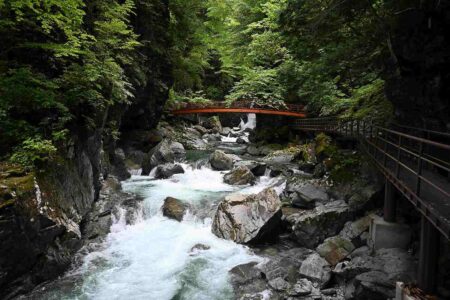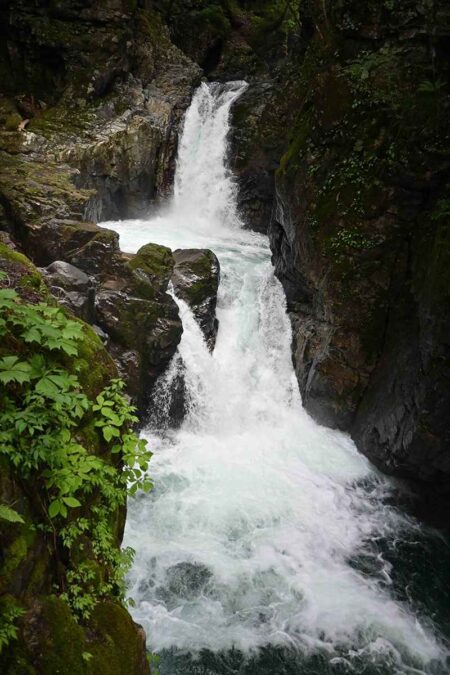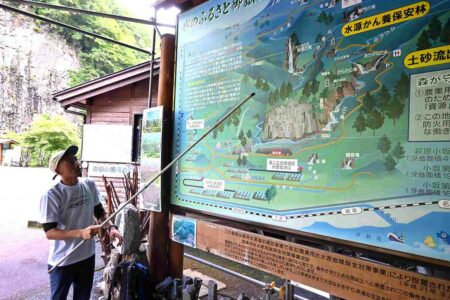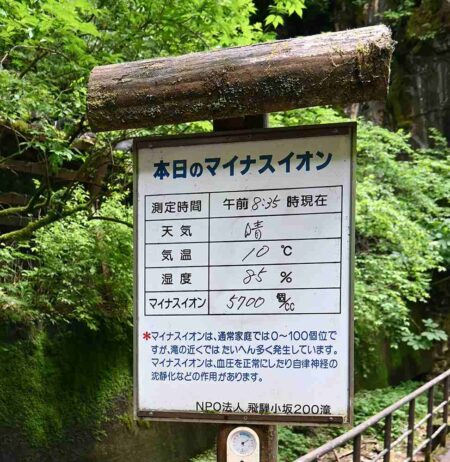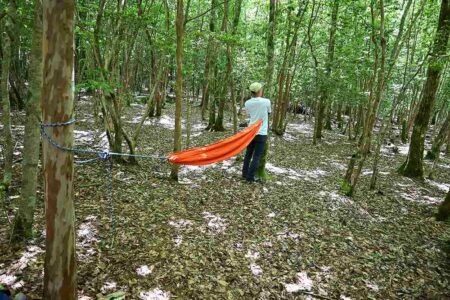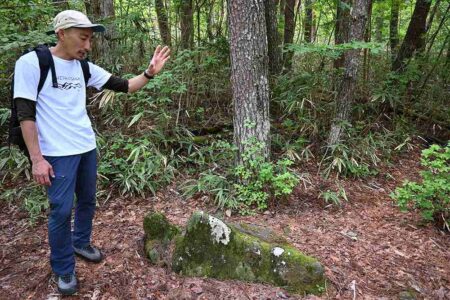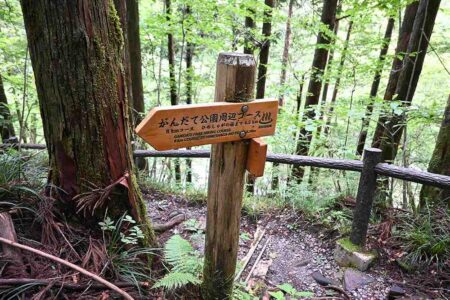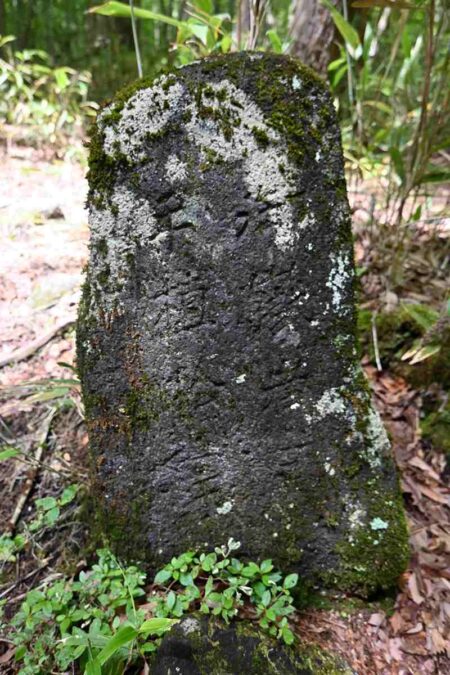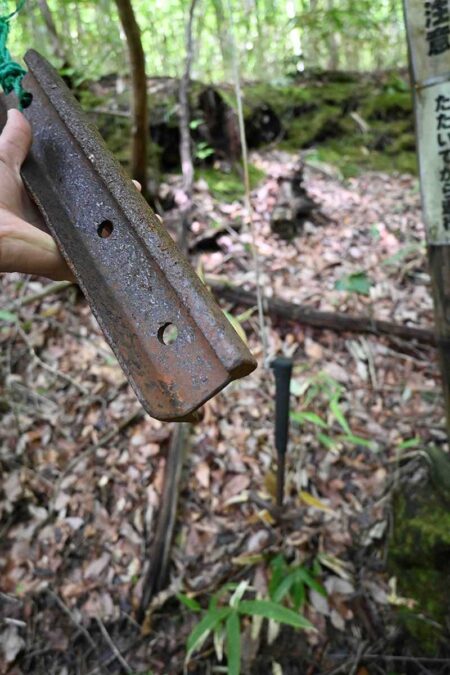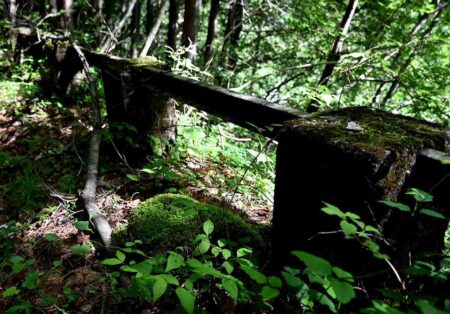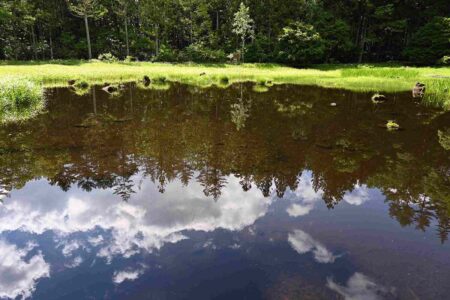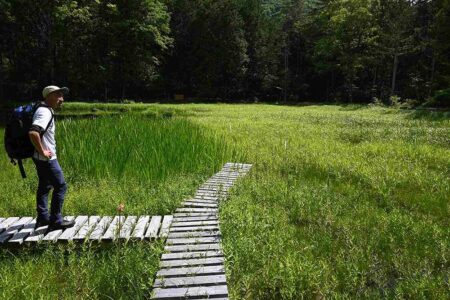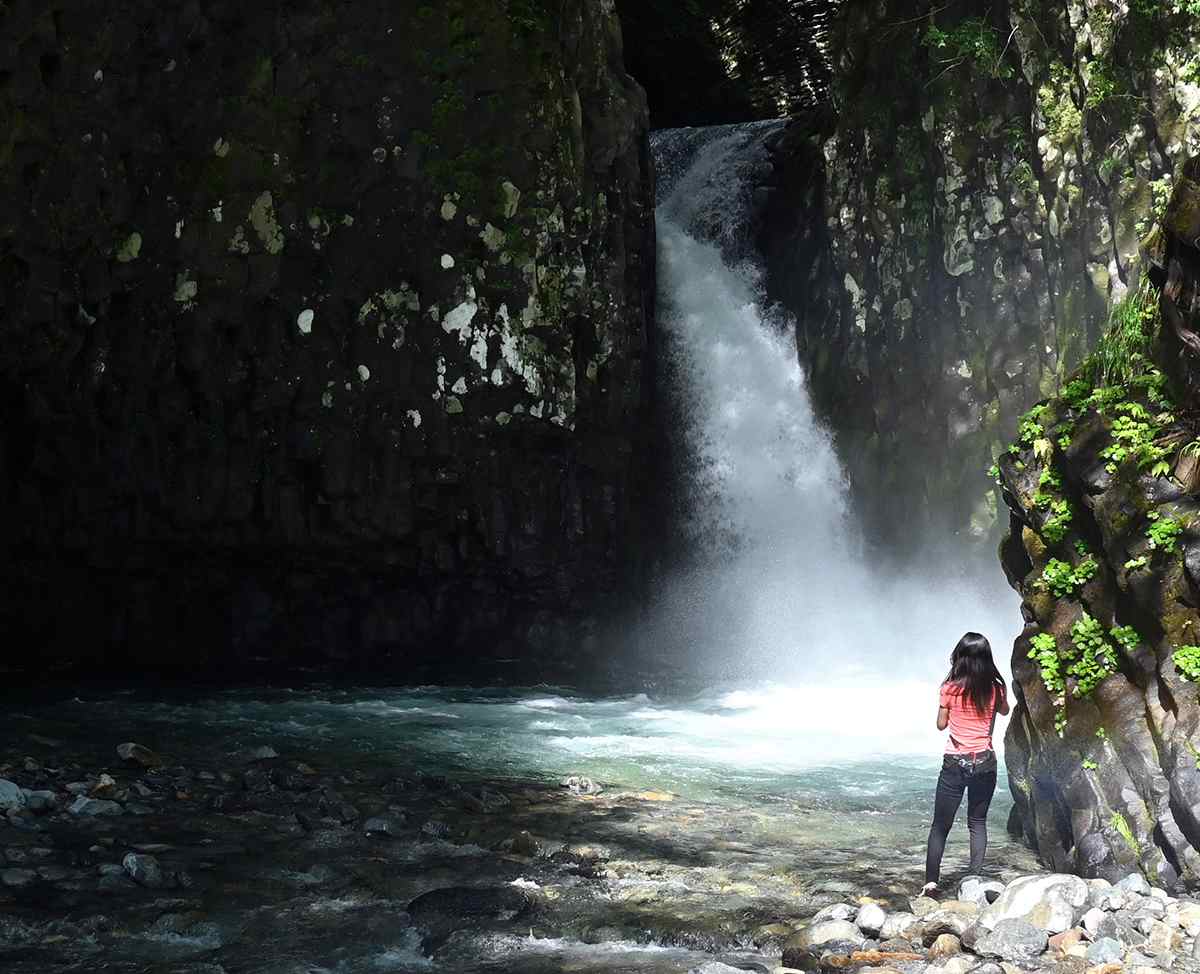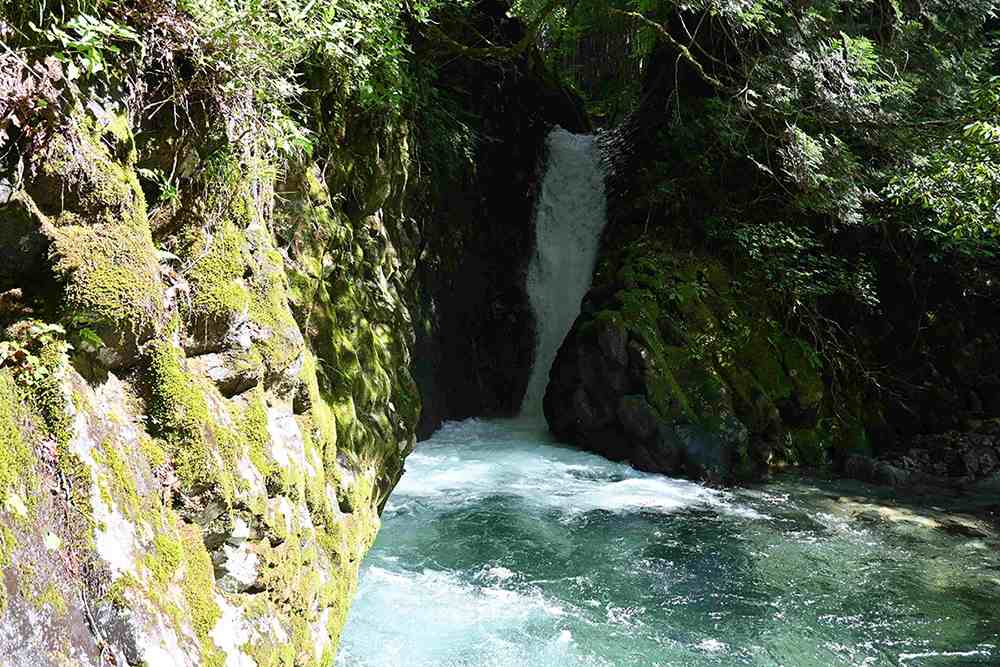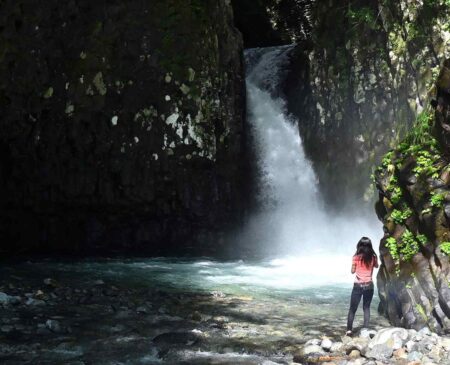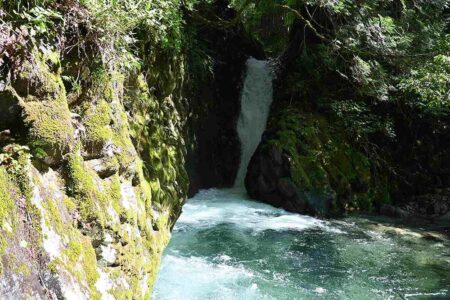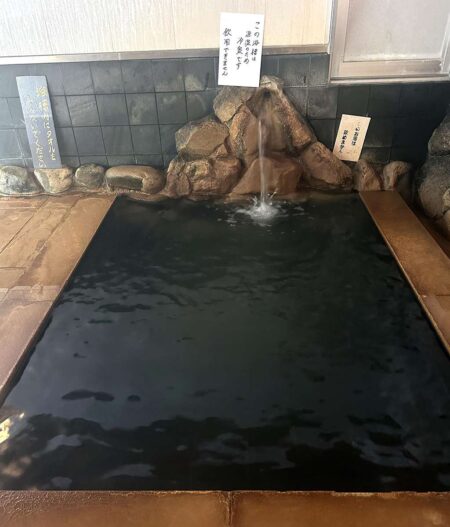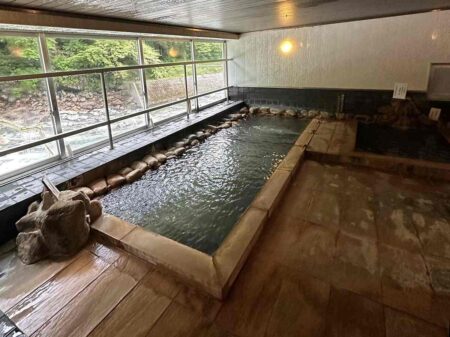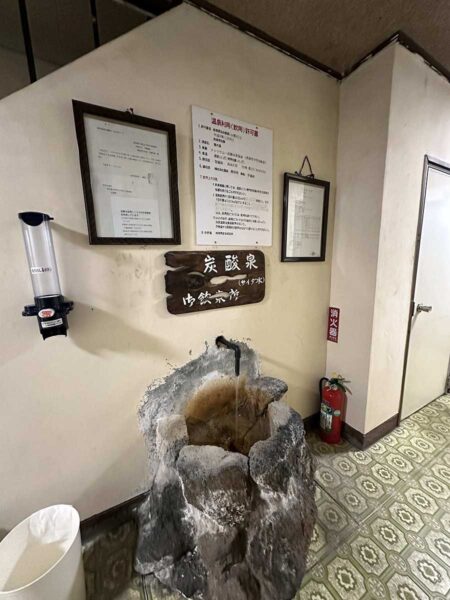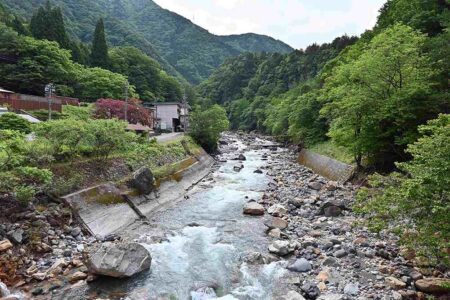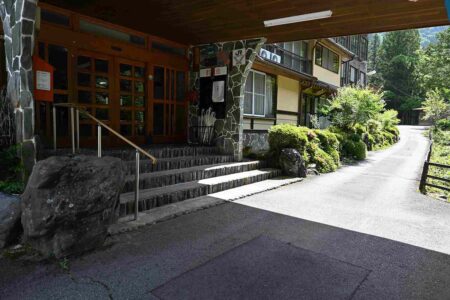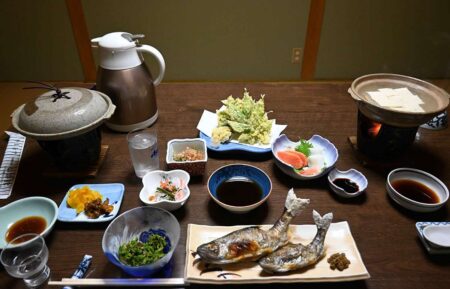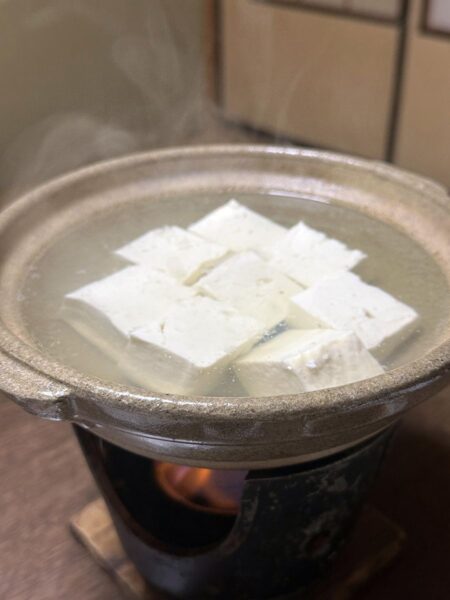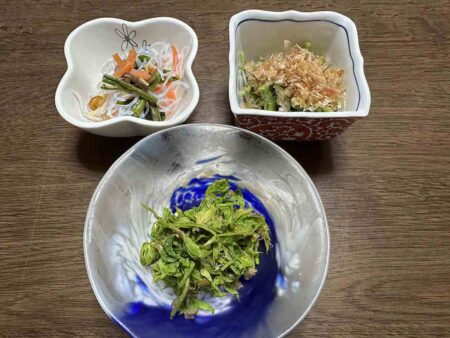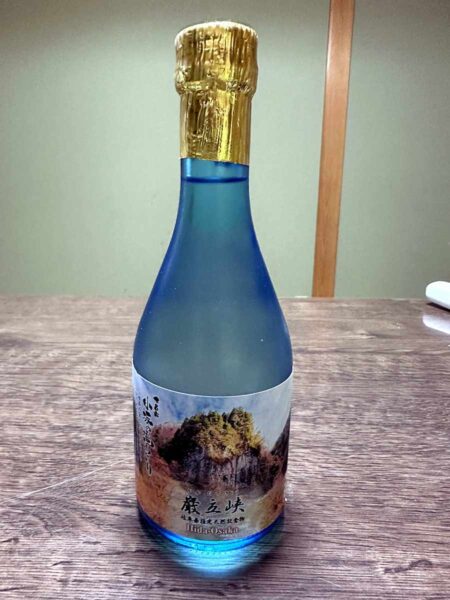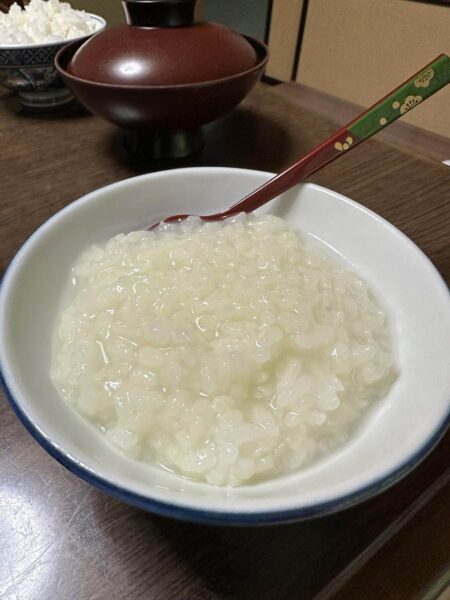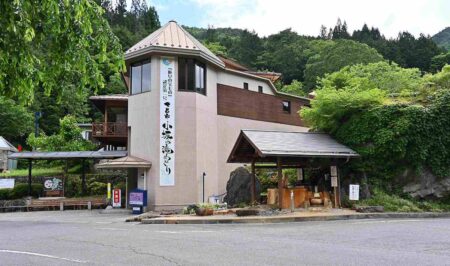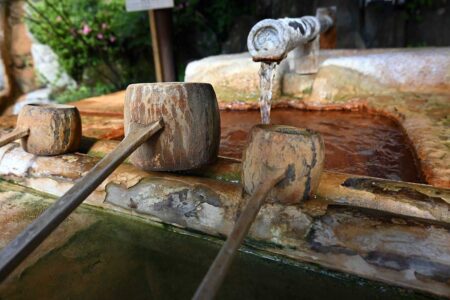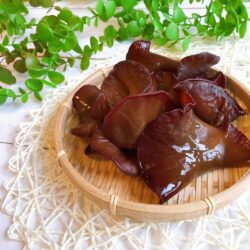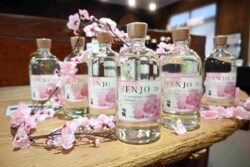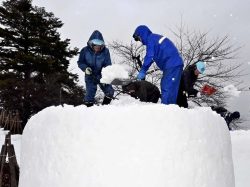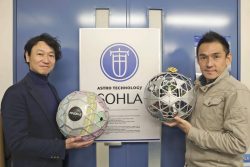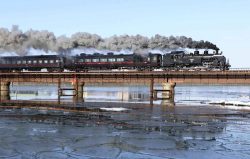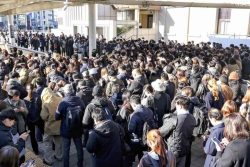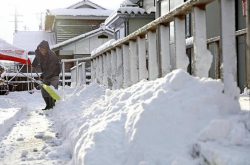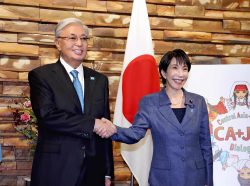Walking through Japan’s Waterfall Paradise Created by Lava; Highly Carbonated Hot Springs Also Popular at Hida-Osaka in Gifu Pref.
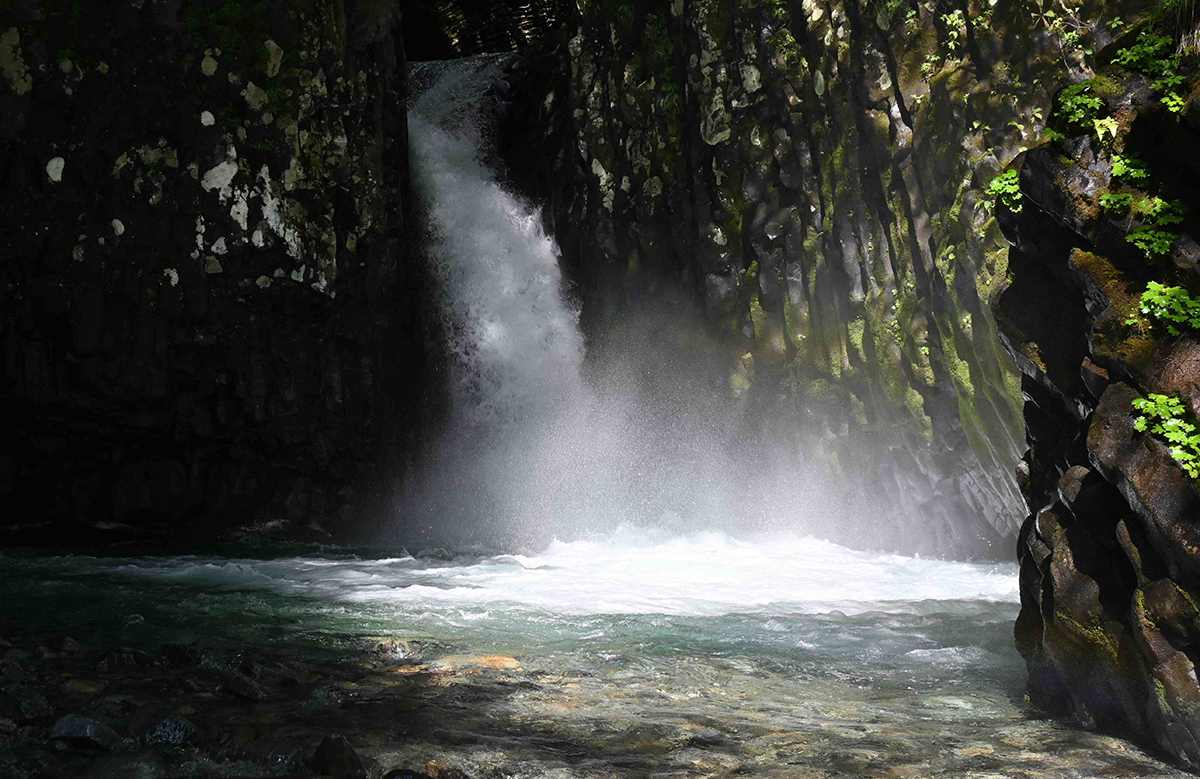
Water from Karatani Falls roars down into the water basin in the Hida-Osaka area in Gifu Prefecture on June 3.
9:00 JST, June 30, 2024
HIDA-OSAKA, Gifu — The roar of a waterfall pierces the serenity of the forest as the wind carries the mist rising from the water basin to every corner of the valley, enveloping my entire body.
Gifu Prefecture’s Hida-Osaka area stretches along the western side of Mt. Ontake, which sits 3,067 meters above sea level. The area is home to countless waterfalls and the Shitajima Onsen hot spring resort. The region is well known for its highly carbonated spring water, a rarity in Japan. The carbonated water will soothe your body after a day of touring waterfalls. Gifu Prefecture invited me to hike through the valley and it promotes these waterfalls and hot springs as part of its sustainable tourism program, NEXT GIFU HERITAGE.
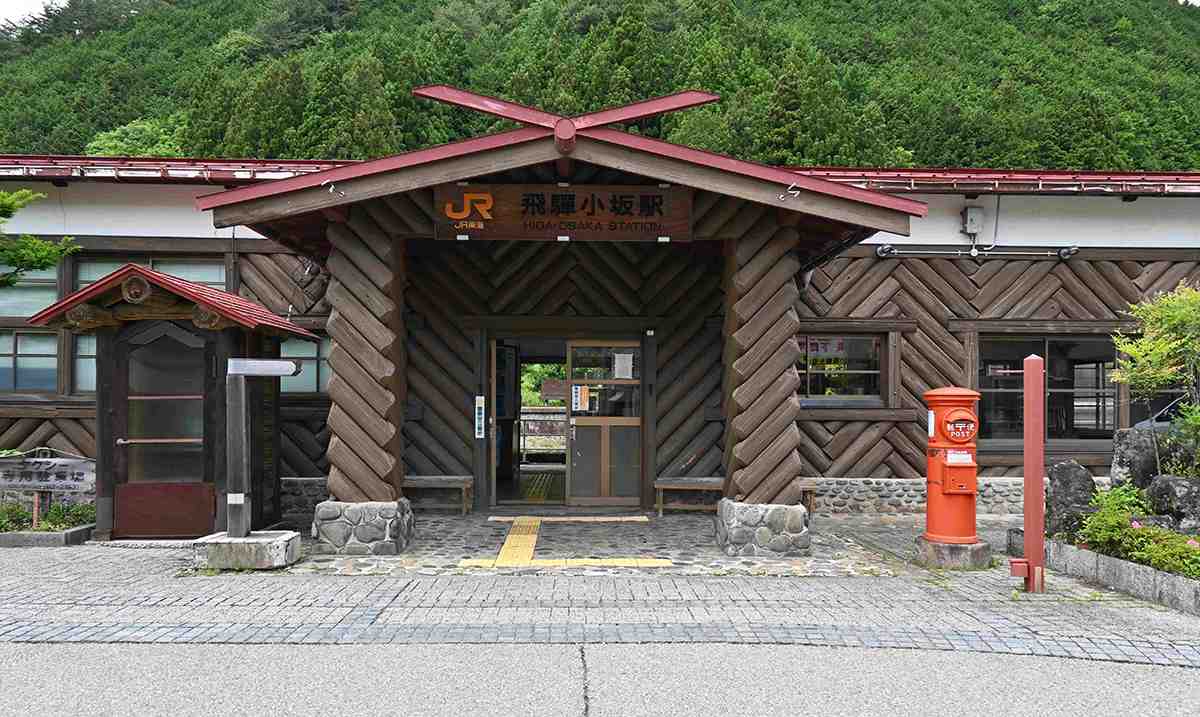
The 91-year-old wooden JR Hida-Osaka Station
“Welcome to Gifu,” greeted Jun Kumazaki, my passionate waterfall tour guide. After taking a Shinkansen bullet train from Tokyo, the Hida limited express and local trains, I arrived at the historic wooden Hida-Osaka Station on the JR Takayama line. We started our hike at Gandate Park, a 20-minute drive from the station.
Upon reaching the park, I was overwhelmed by the stone cliffs created by lava in front of the parking lot. “Gandate is a cross-section of a lava flow created by the eruption of Mt. Ontake about 54,000 years ago,” Kumazaki explained. The vertical rock surface is now exposed after repeated collapses and peeling due to earthquakes, wind and rain.
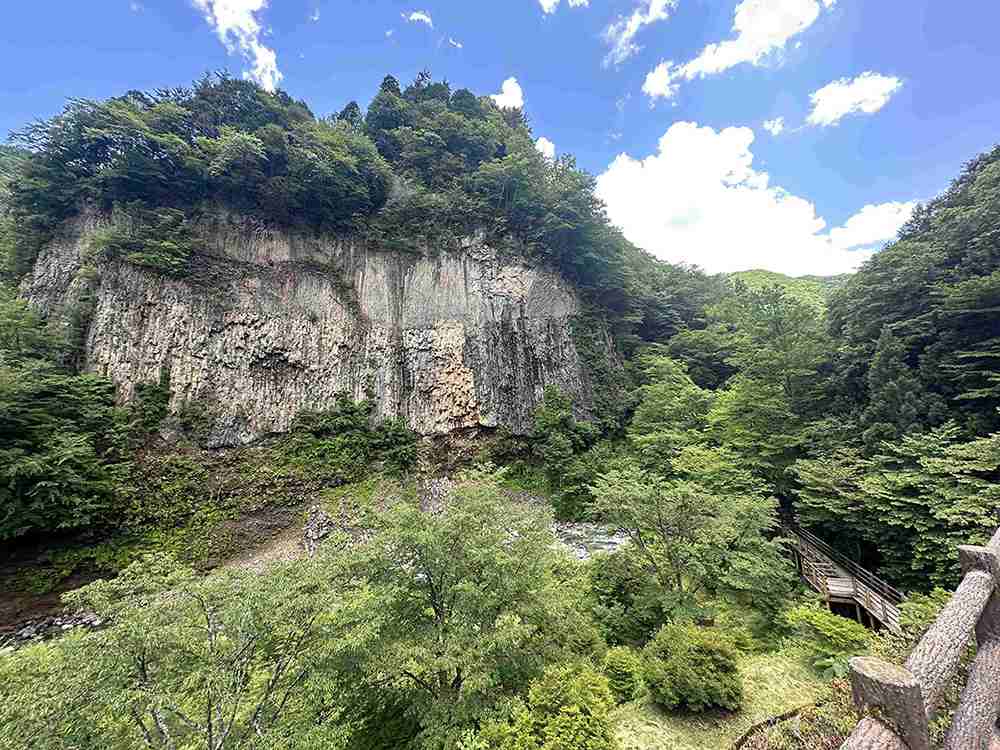
The Gandate lava plateau, located in front of the parking lot
This huge lava plateau sandwiched between two rivers is approximately 72 meters high and 120 meters wide. Above it lies a forest.
The elevation difference from the plateau to Mt. Ontake’s summit is over 2,000 meters. An abundance of water flows down the steep terrain very quickly, which has led to the formation of many waterfalls. In fact, due to the high number of falls, only those over 5 meters high are counted as waterfalls. Residents claim the title of “the town with the most waterfalls in Japan,” with over 200 designated waterfalls. The NPO Hida-Osaka 200 falls, a non-profit organization consisting of residents, offers guided tours to ensure that visitors can safely enjoy these waterfalls.
Our 3-hour beginner trail hike took us from the river to the forest at the top, then down through an artificial wetland and back to the parking lot. Three waterfalls were along the trail. Once we entered the riverside trail, the temperature dropped dramatically. “Thanks to the cold river current, the temperature here is in the 20s even in mid-summer,” Kumazaki said.
-
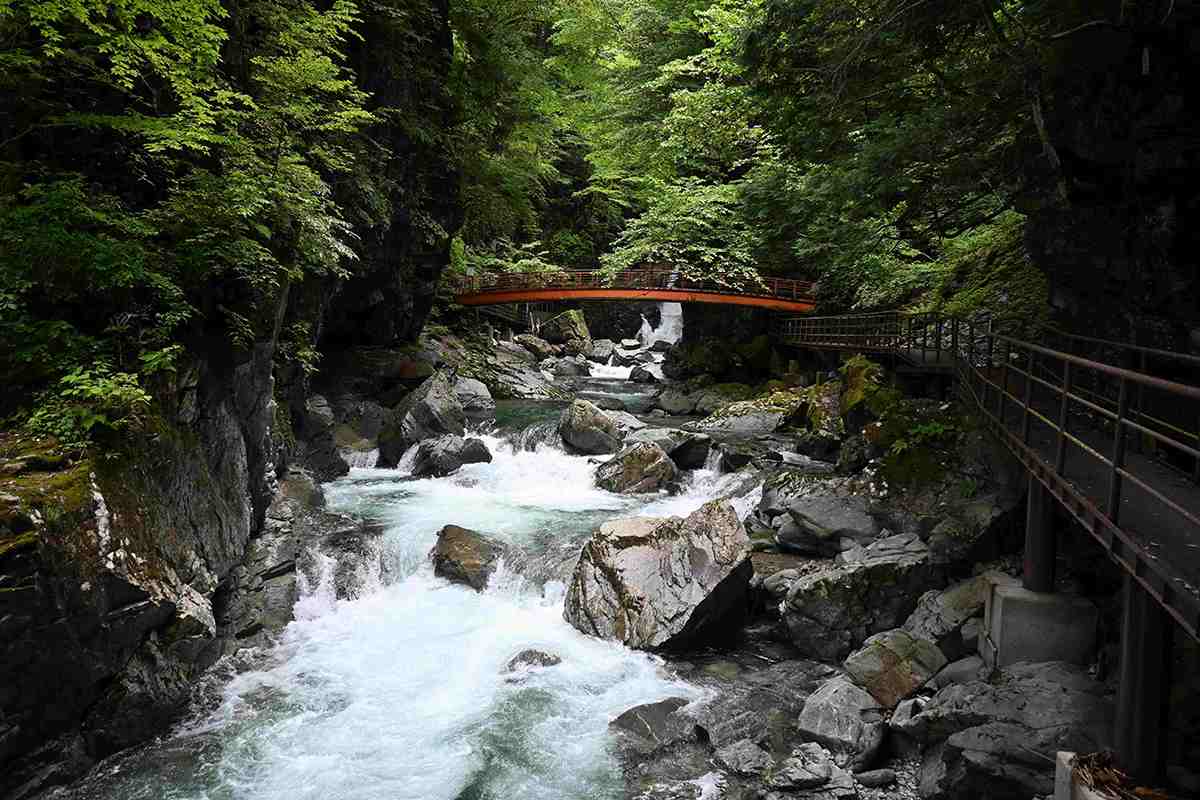
A waterfall and bridge located along a riverside walking trail starting from the parking lot.
-
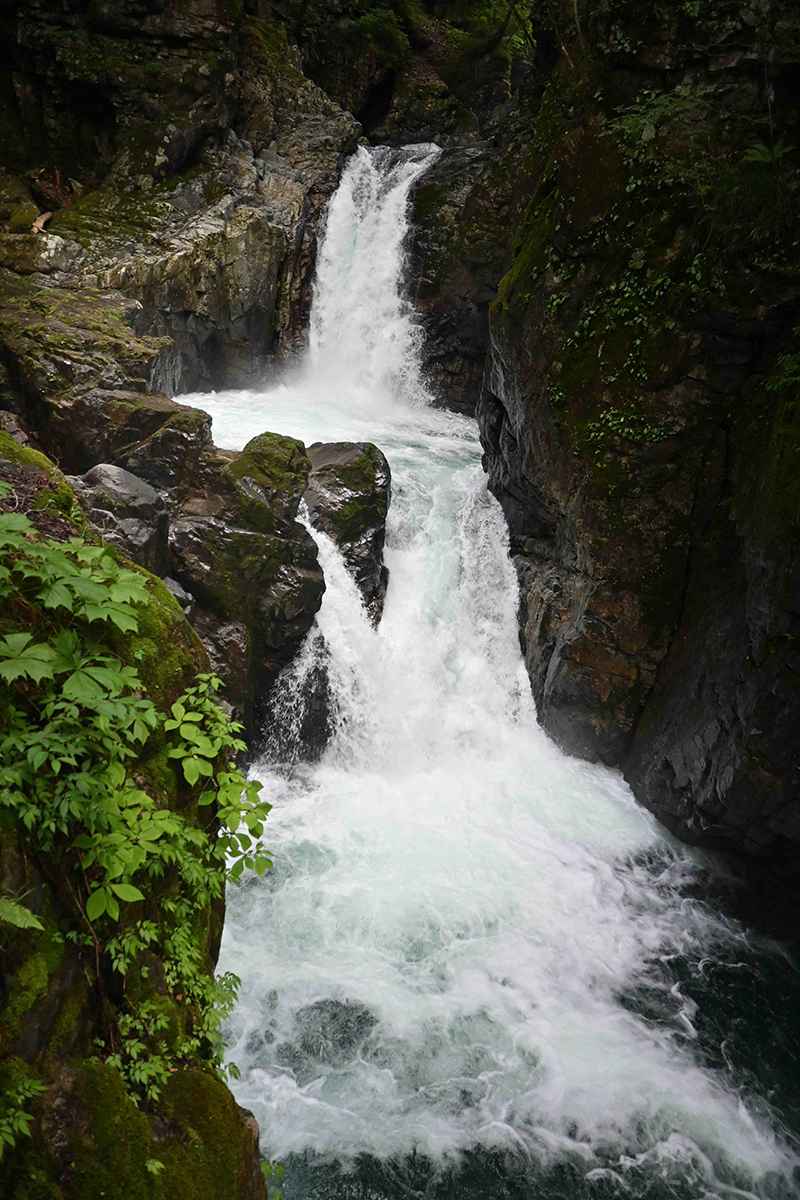
Mitsudaki Falls as seen from the bottom
-
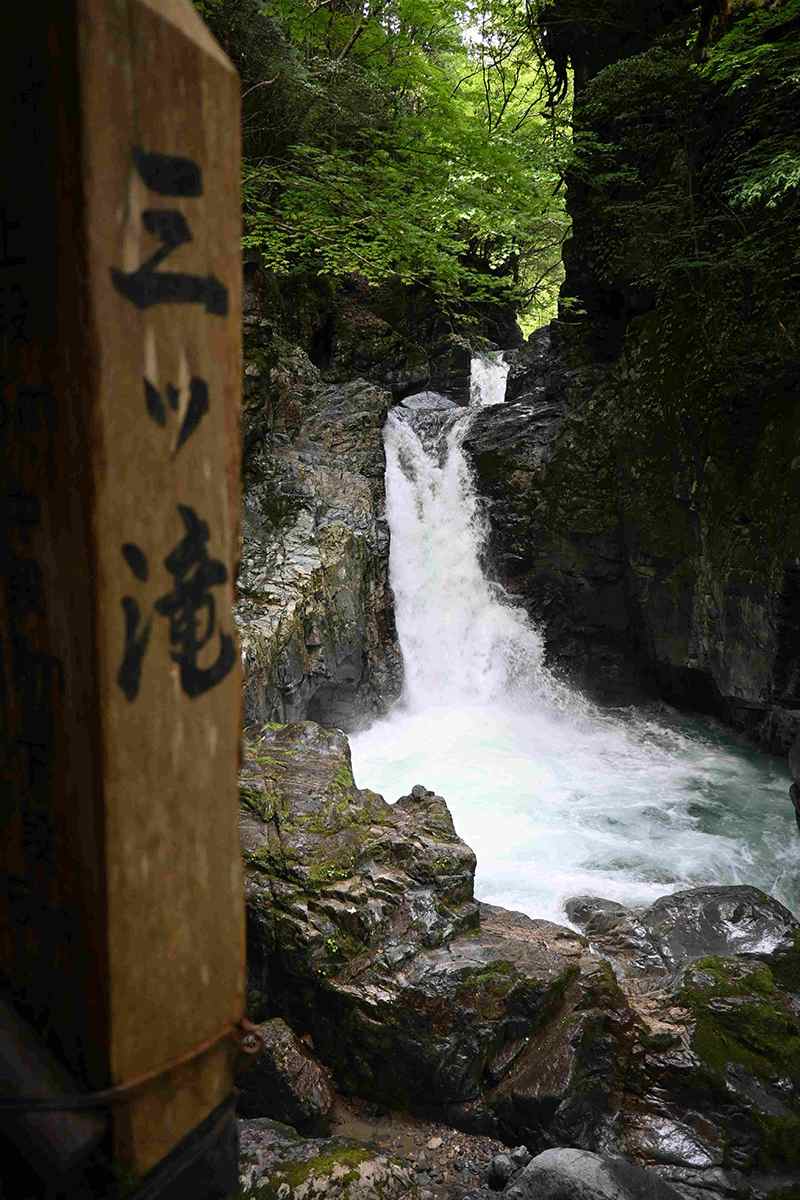
Mitsudaki Falls seen from its middle tier
-
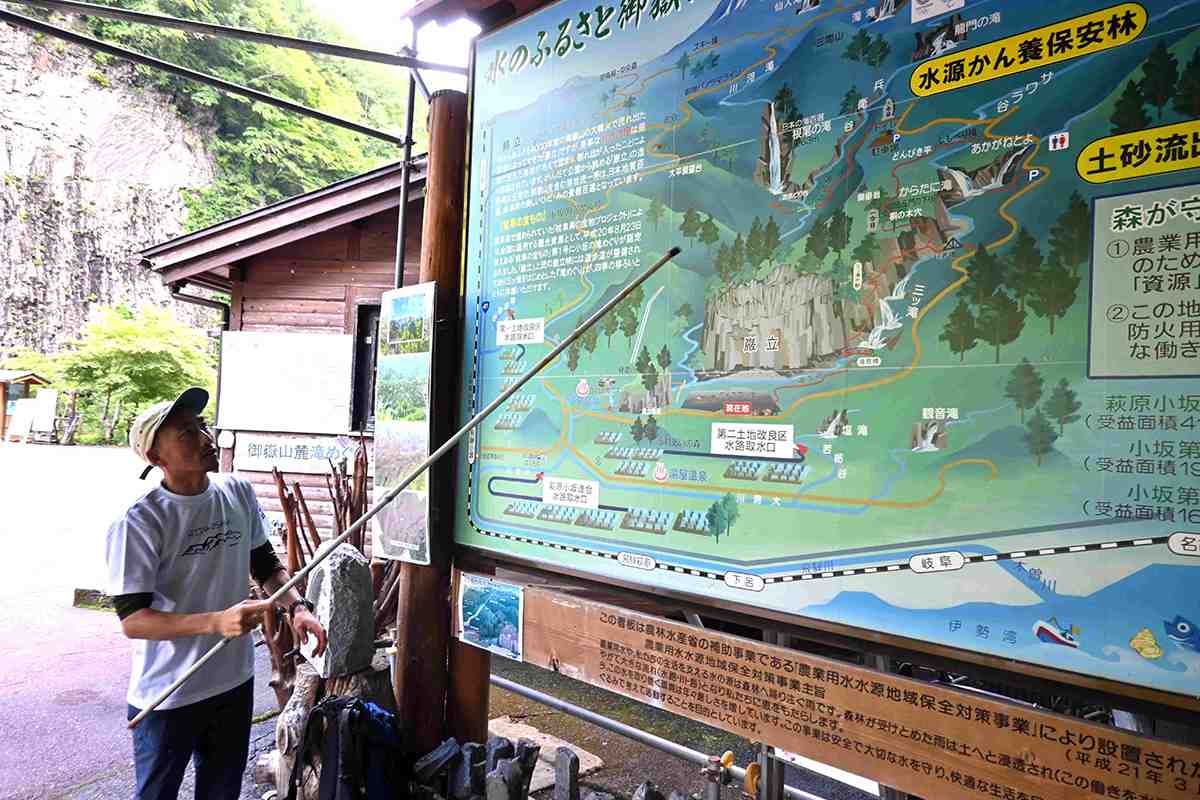
Jun Kumazaki, a waterfall tour guide, explains about the great eruption of Mt. Ontake about 54,000 years ago.
-
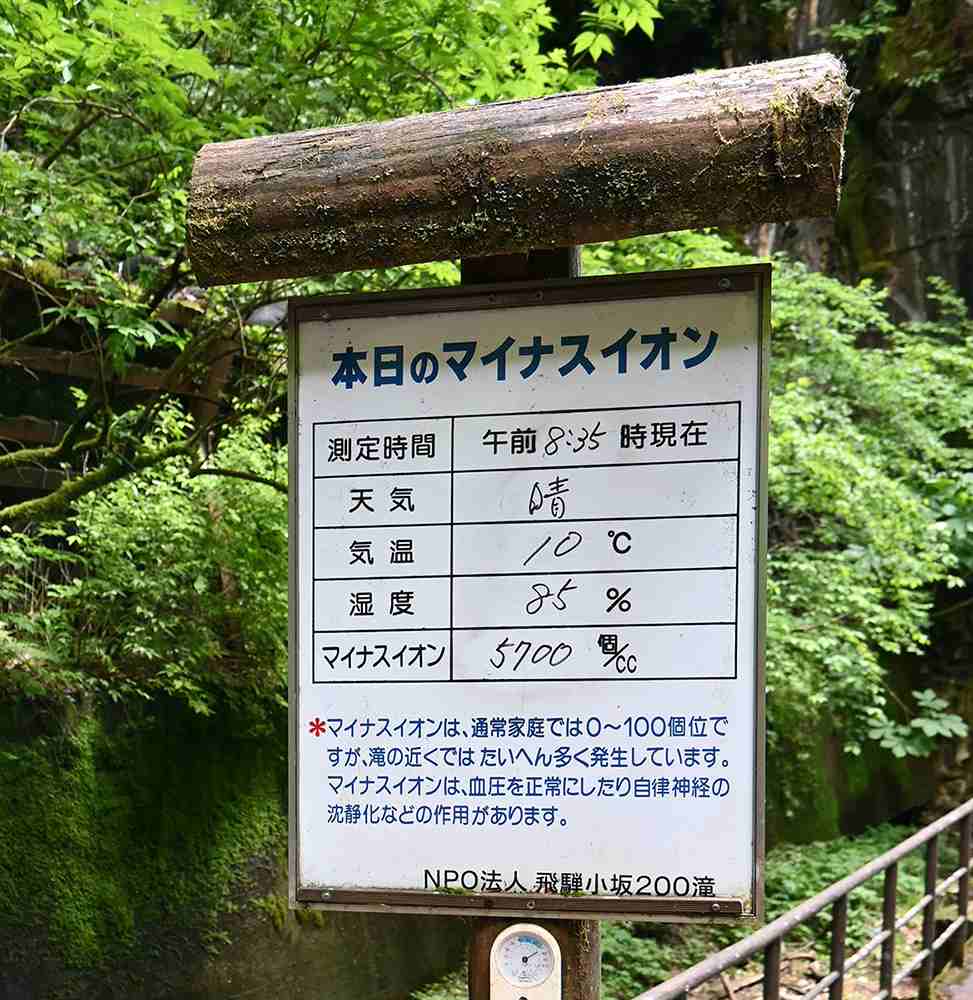
Every day the number of negative ions in the area is measured and written on a sign. On June 3, the sign read there was 5,700 negative ions per 1 cc.
I noticed a sign that read “Today’s negative ions.” Negative ions are charged particles that can be created when water collides with itself, like in waterfalls. On the day, the concentration of negative ions was over 50 times higher than in an average household. “This may be why our senior guides, who are in their 80s, are so energetic,” 41-year-old Kumazaki said with a smile.
After just 10 minutes we arrived at the first waterfall, Mitsudaki, which has multiple tiers. “Interestingly, you can see the falls not only from the front but also from the top, side and back from the boardwalk,” Kumazaki said. “It is truly a delight that we can observe the falls from so many angles only 10 minutes from the parking lot.”
Buoyant forest
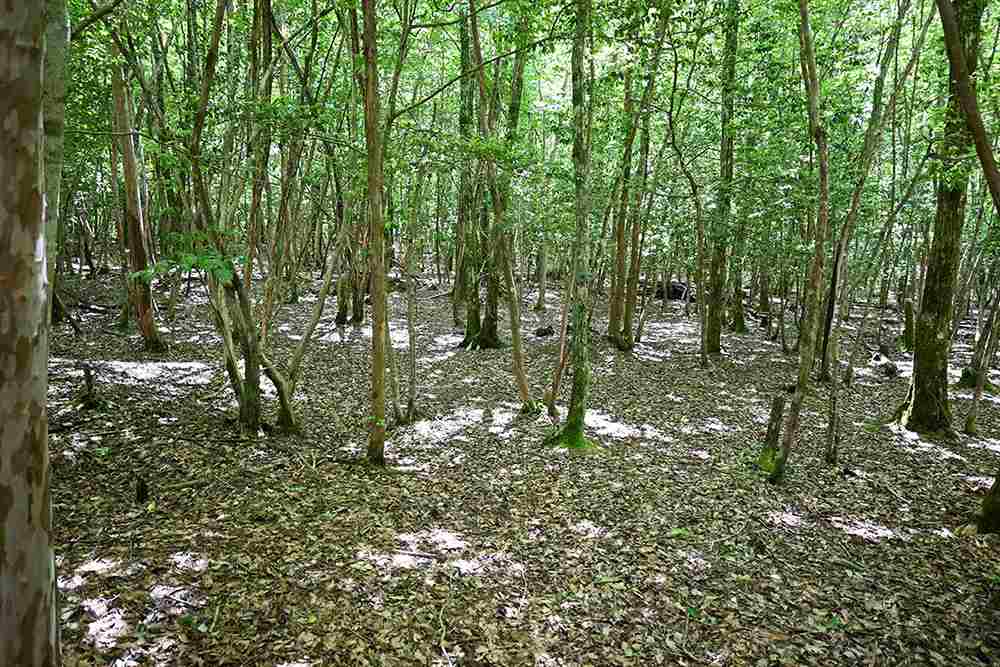
The forest on top of the lava plateau
After a while, we entered the forest at the top of the lava plateau. Kumazaki pointed at the ground, and I noticed a small bluish translucent plant. The saprophytic plant is ginryoso and seemed to be floating dimly above the ground. Because of its appearance, it is also called yureiso, which means ghost plant in Japanese. “It is a messenger of the rainy season,” Kumazaki said. “When it appears, the rainy season comes.”
-
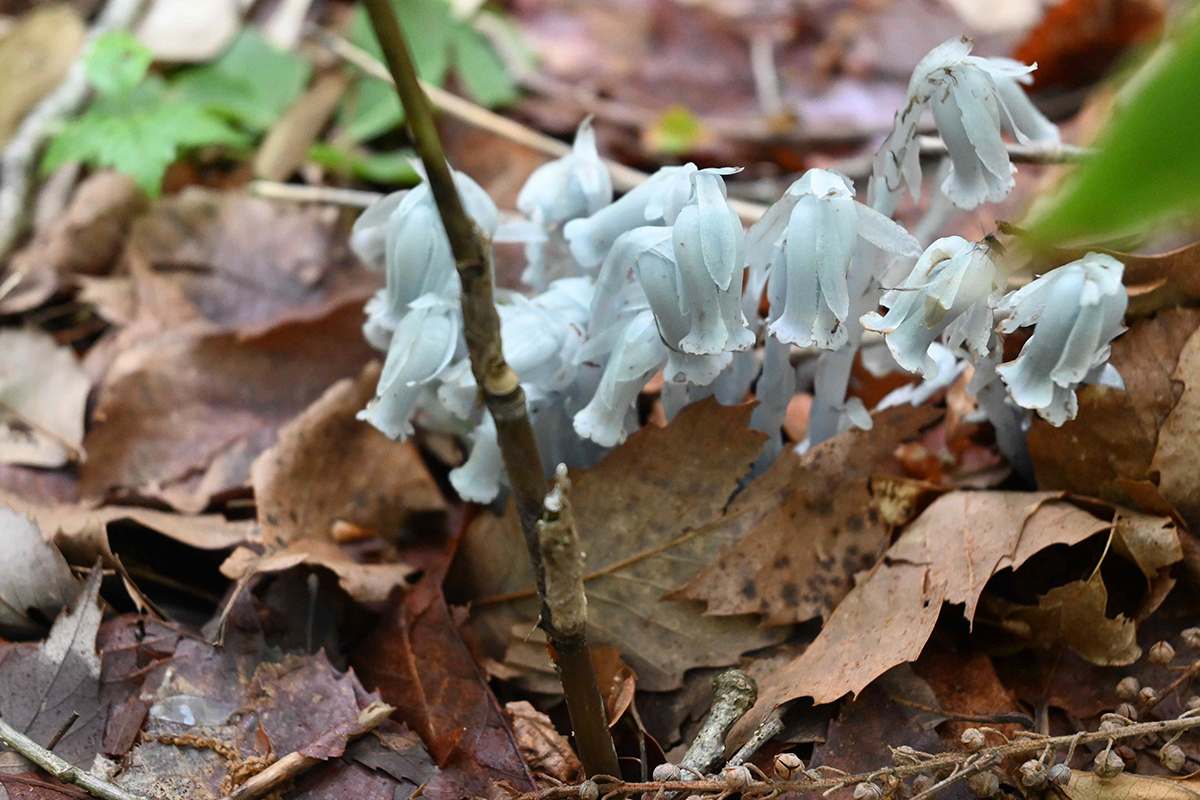
Ginryoso, a bluish saprophytic plant said to be the messenger of the rainy season
-

Preparing a hammock
-
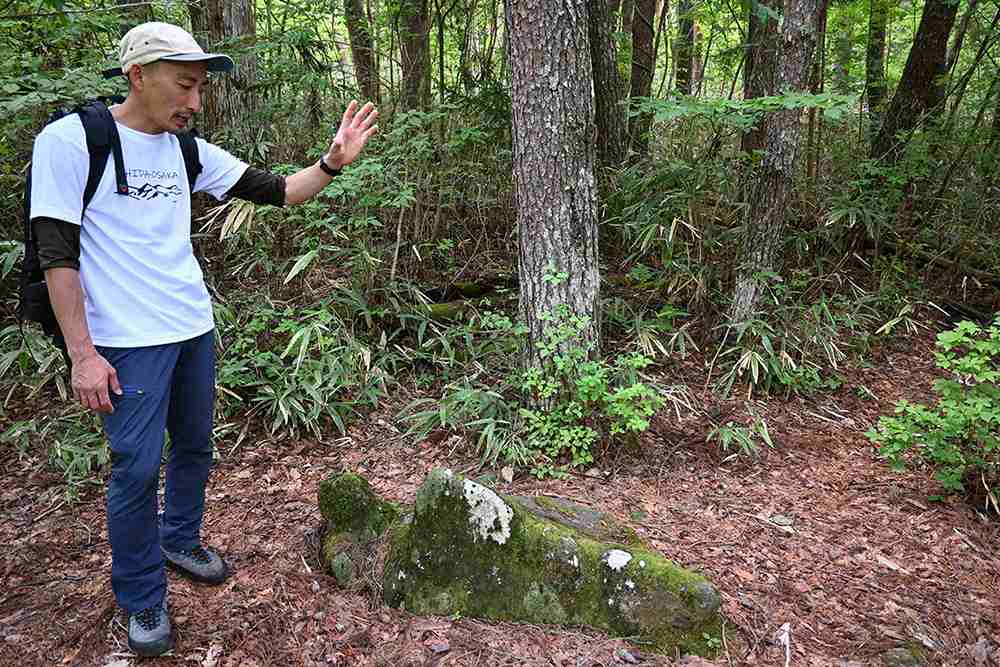
A rock that is said to have appeared out of the ground after the death of Kakumei Gyoja who opened the mountain to the public.
-
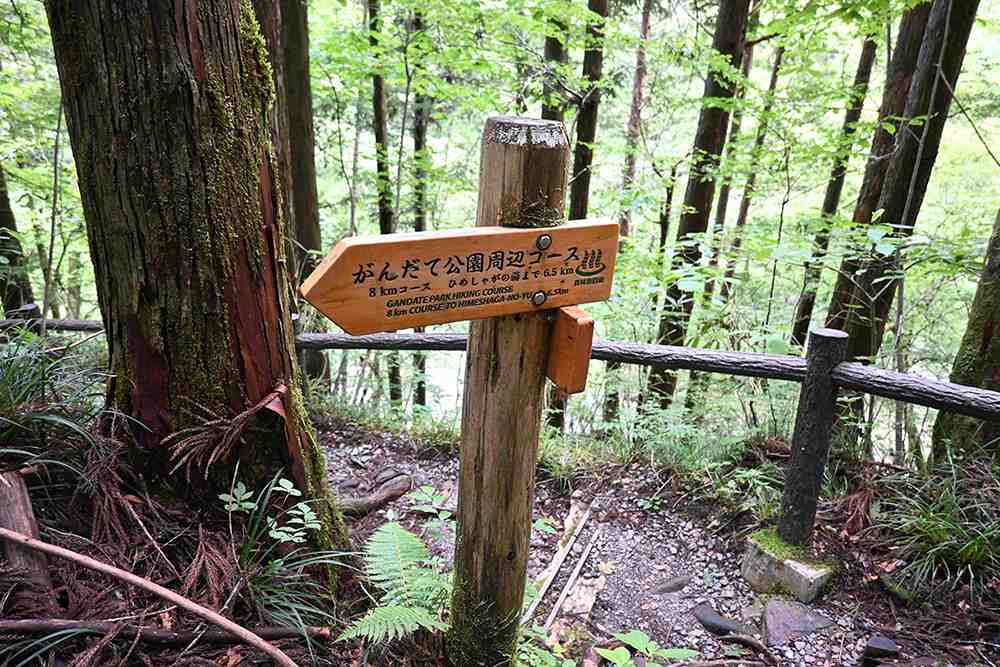
Direction signs along the trail guide walkers.
-
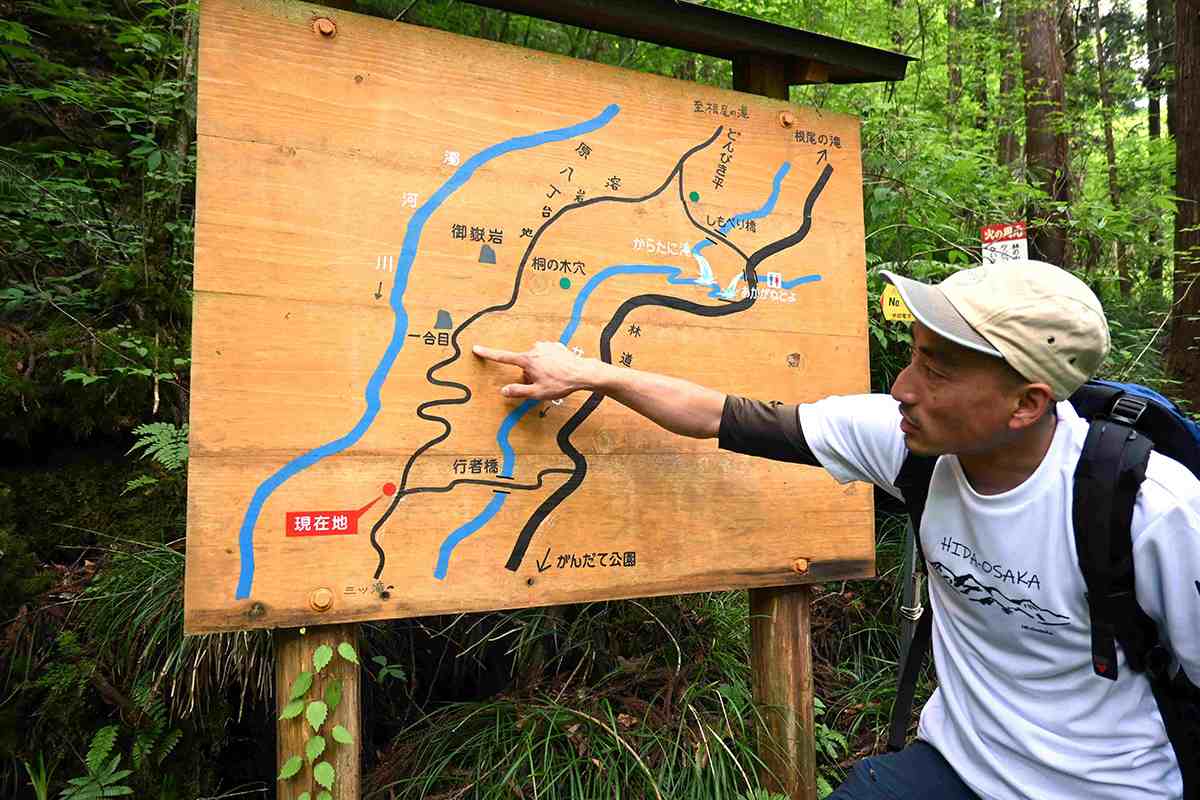
Jun Kumazaki gestures while explaining about the trail.
The forest is called hara-haccho, which refers to a spread-out field. The name comes from when trees were cut down in the old days to be turned into charcoal, turning the forest into a field. Now that the practice is no longer in use, the trees here are relatively new and have shallow roots in the humus that is only a few meters deep. I could feel the shallow soil’s softness as I walked on the slightly bouncy ground. At the edge of the cliff, all I could hear were the sounds of the Nigorigo River flowing far below. Kumazaki set up a hammock for us and I let my mind wander amid the comfortable swaying.
Artificial marshland
-
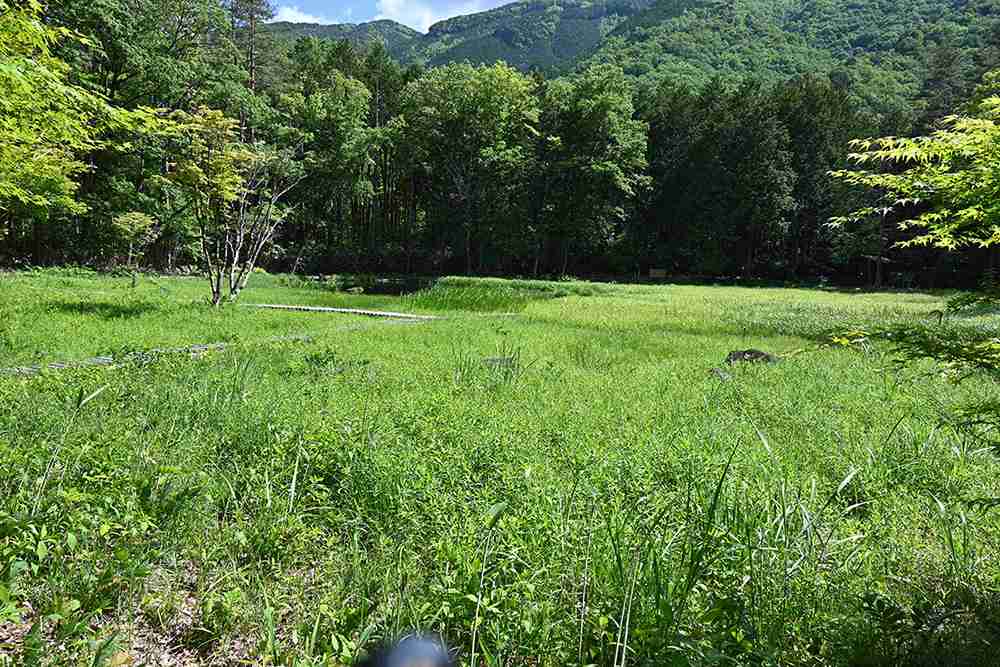
Dobiki-daira, a beautiful artificial marsh
-
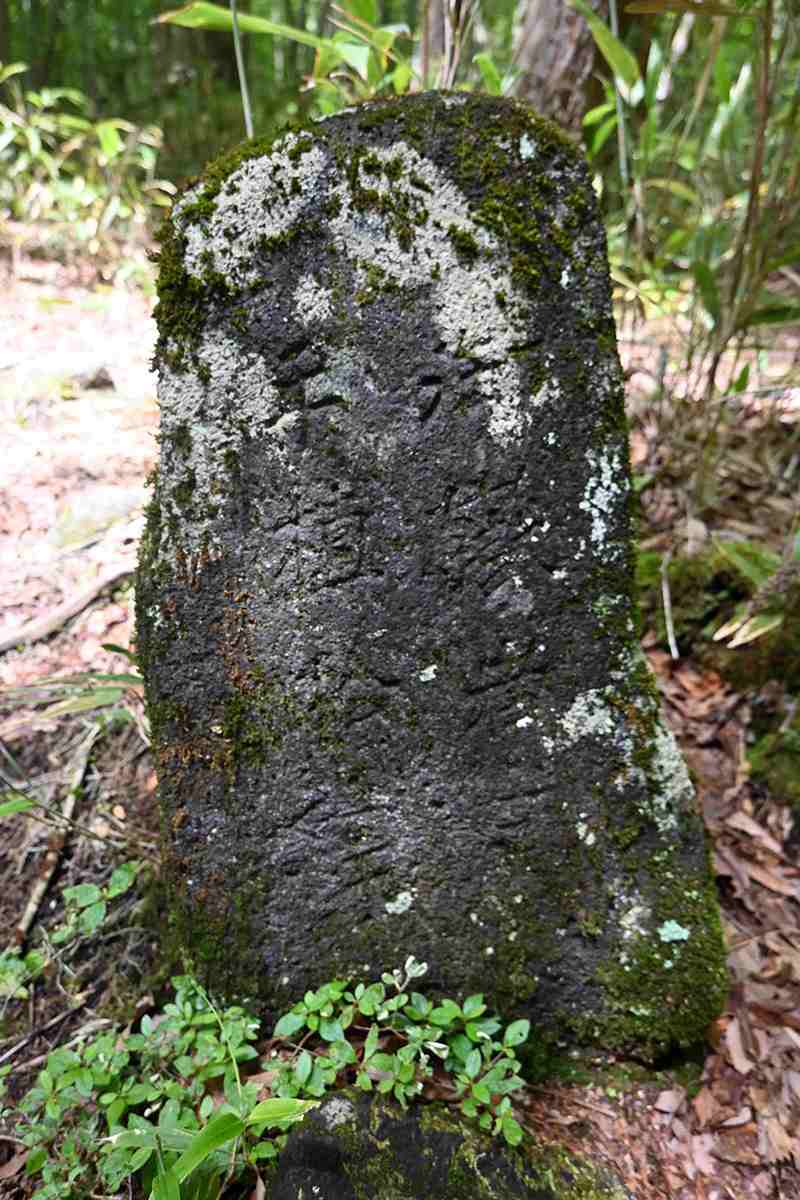
Some extremely old stone signposts remain on the trail.
-
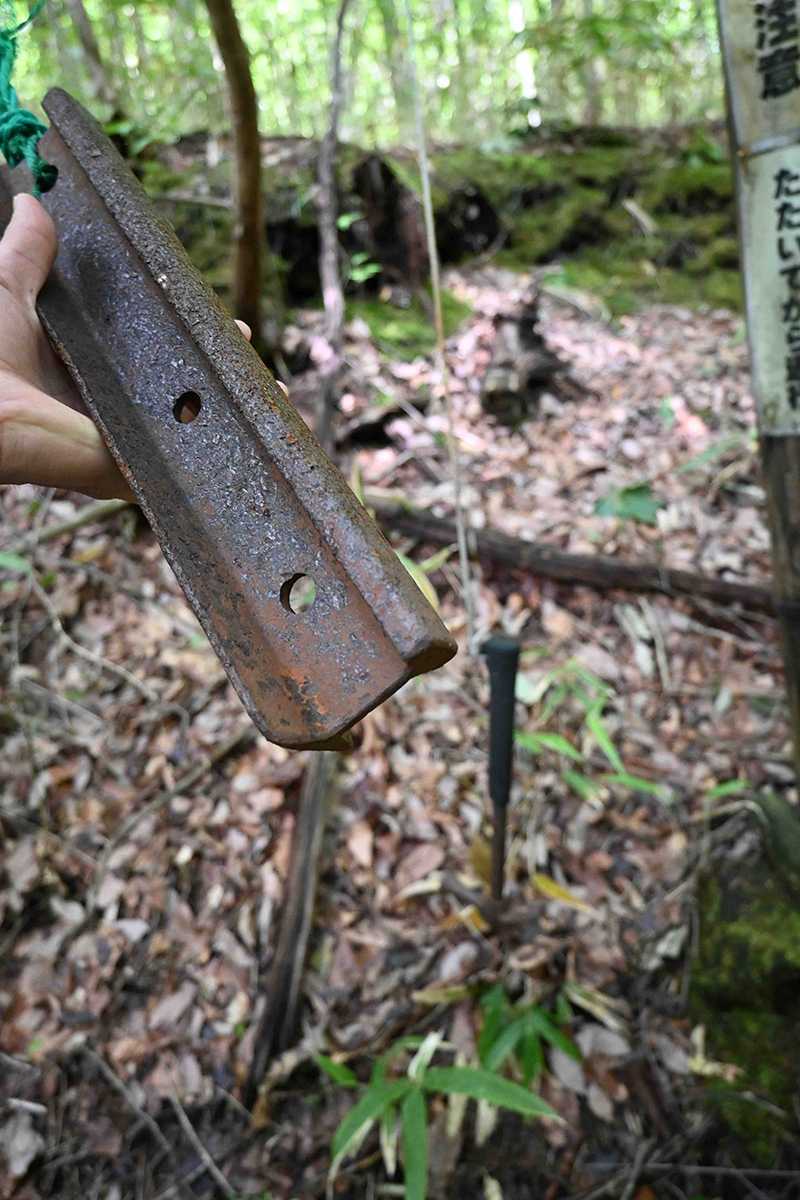
Part of forest railroad track is used as a bear bell.
-

A forest railroad track that also acts as a guardrail.
Kakumei Gyoja, a Buddhist practitioner in the mid-Edo period (1603-1867) opened the Ontake mountain trail to the public. Visitors have long come to the lava flow valley because of the mountain worship of Mt. Ontake, giving the valley a diverse history. The forestry industry has flourished for a long time in the region since the Edo period, and wood transport has changed from boats to railroads and trucks. Some forest railroad tracks remain along the trail, albeit in a dilapidated state. Some part of them are utilized for bear bells, and another part act as guardrails for vehicles.
-
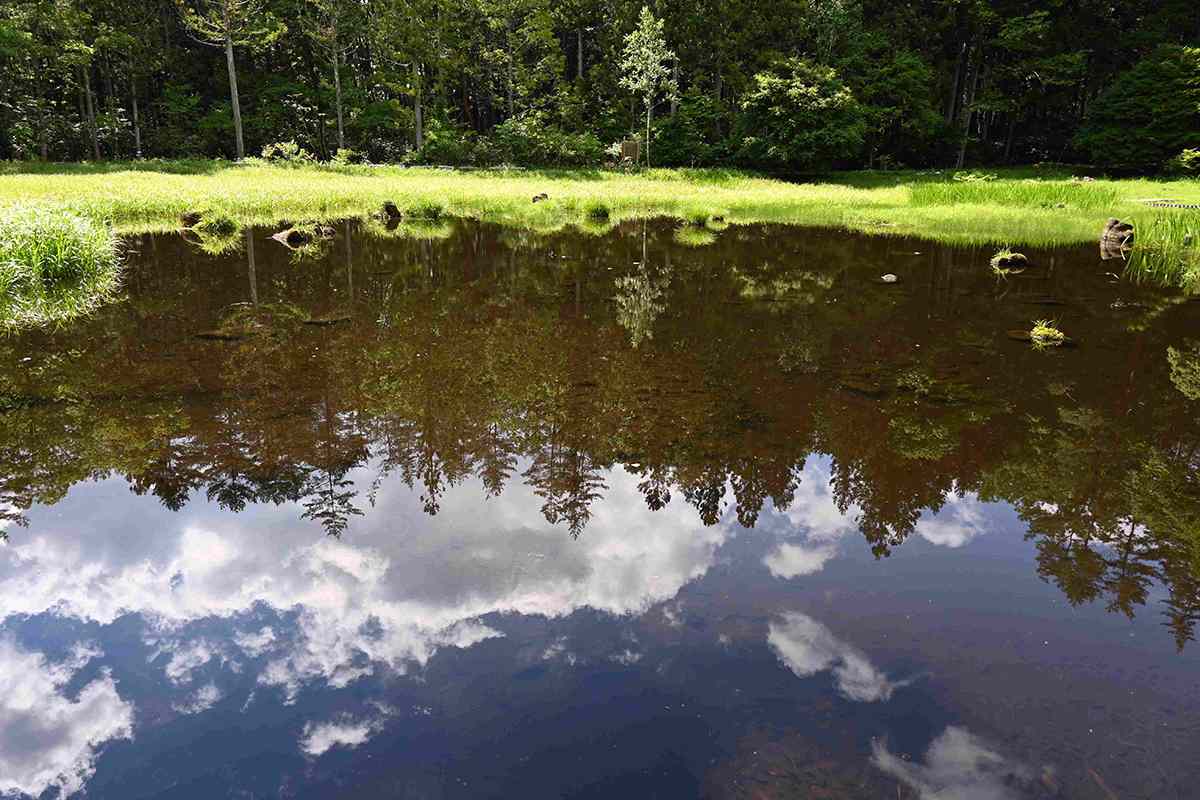
The surrounding scenery is seen on the mirror-like surface of the water.
-
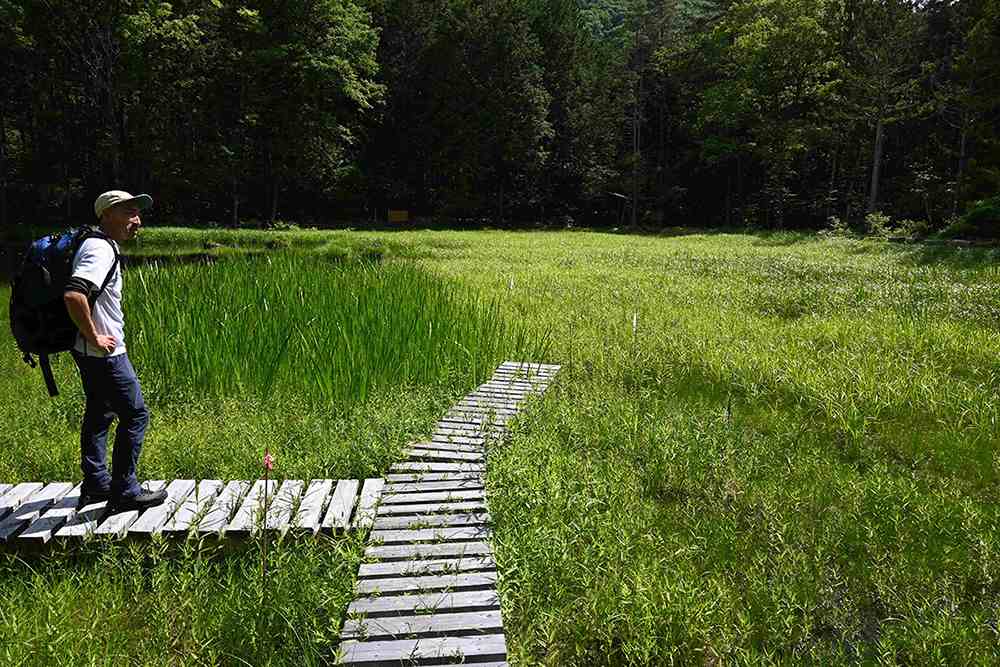
Wooden paths are maintained in the marsh for visitors to walk on.
The trail began to descend as we continued, and the beauty of the marshland took my breath away. The mirror-like surface of the water reflected the surrounding trees. When the leaves turn red in the fall it is even more beautiful.
Kumazaki posed the question, “Why is there a marshland on this plateau when there is no water?” He then explained: “This is an artificial marshland. Originally, rainwater tended to accumulate here.”
When the forestry industry flourished, it was also used as a lumber site. After that ended, the area was overgrown with grass and trees. However, in recent years, the marshland has been brought back to life through the efforts of the local Chamber of Commerce and Industry and the NPO Hida-Osaka 200 falls.”
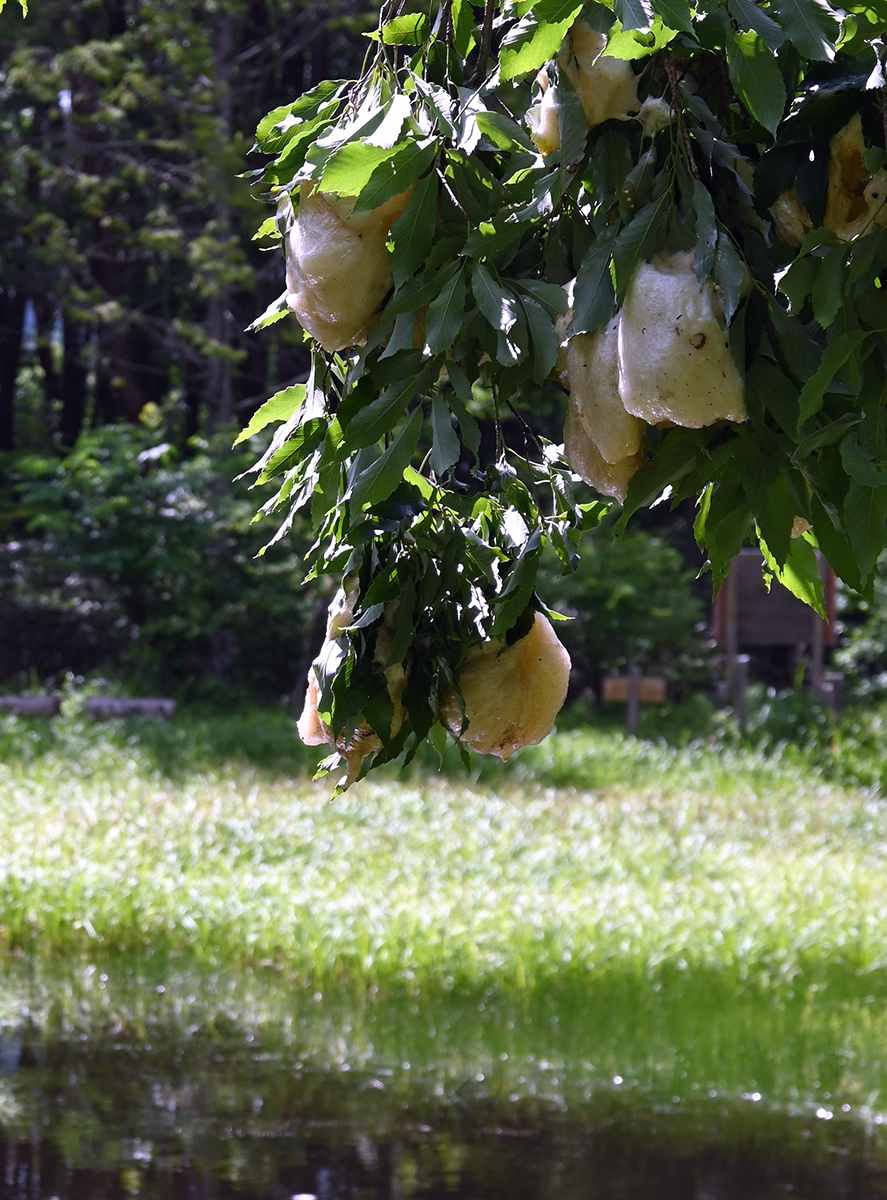
Egg masses of forest green tree frogs on a tree branch hanging over the water
The marshland is commonly known as Donbiki-daira and is a paradise for frogs. Donbiki is the local word for frogs and various species live here. I saw multiple globular-shaped frog egg masses on a tree branch above the water. This was the first time I had seen these in person. “You could say that this is an ecosystem created by human intervention. I think it is a positive change,” Kumazaki said.
However, protecting this environment requires much work, such as cutting down plants that quickly reproduce. The work is carried out by people including members of the NPO Hida-Osaka 200 falls, but the area’s rapidly aging population means that it is chronically short of labor. Kumazaki, one of the youngest in the group, said, “We would be grateful if people came and grew to like this place so they could help us.”
Living together with waterfalls
As our hike ended, we visited two waterfalls: Karatani and Akaganetoyo. The Karatani Falls particularly left a lasting impression. The tremendous volume of water roaring down made it impossible to converse. I was immersed in the world of the waterfall, my whole body enveloped in a cloud of mist. People relaxed on nearby rocks. Spending a day by this waterfall, soaking up the negative ions, will make all your small worries float away.
“I live with the waterfall. That is my life,” said Kumazaki, who was born and raised in Hida-Osaka. “The residents did extensive research on the waterfalls and published a photo book in 1983, the year I was born. Children couldn’t go to most of the waterfalls, but I grew up looking at the book. It is my bible.”
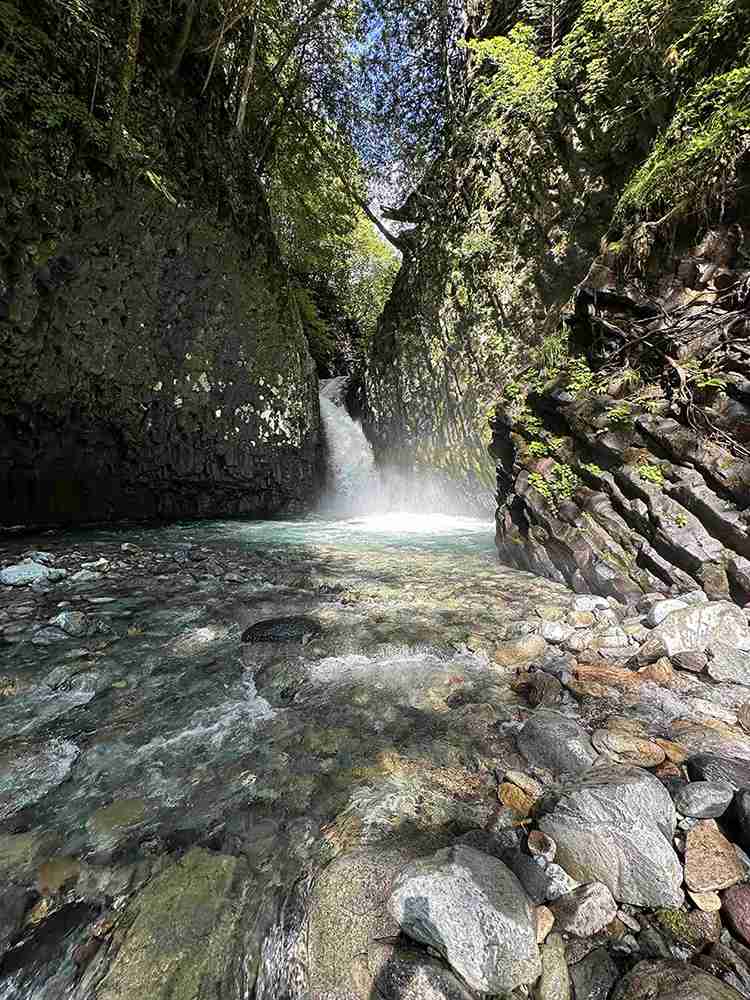
Another view of Karatani Falls on June 3.
When Kumazaki grew up, he visited the waterfalls in the photo book and became even more captivated by them. “Waterfalls are alive. They change with the seasons and the amount of rainfall, and in the long run, they disappear, or new ones are born as the topography of the lava plateau changes,” Kumazaki said enthusiastically.
Kumazaki, who is currently based in Hida-Osaka and works as a mountain guide across Japan, said that climbing other mountains has led him to new discoveries and revealed some of the challenges the Hida-Osaka region faces. But he said confidently, “Waterfalls here are the best.” In spring and fall, visitors can tour the waterfalls, in summer they can enjoy canyoning climbing and in winter they can take an ice fall tour. Middle and high-level courses include waterfalls up to 50 meters in height. Kumazaki is also an English-speaking guide, and there is a female guide who is certified as an interpreter. Kumazaki hopes that people from all over the world will visit Hida-Osaka and discover its beauty.
Highly carbonated hot springs
-
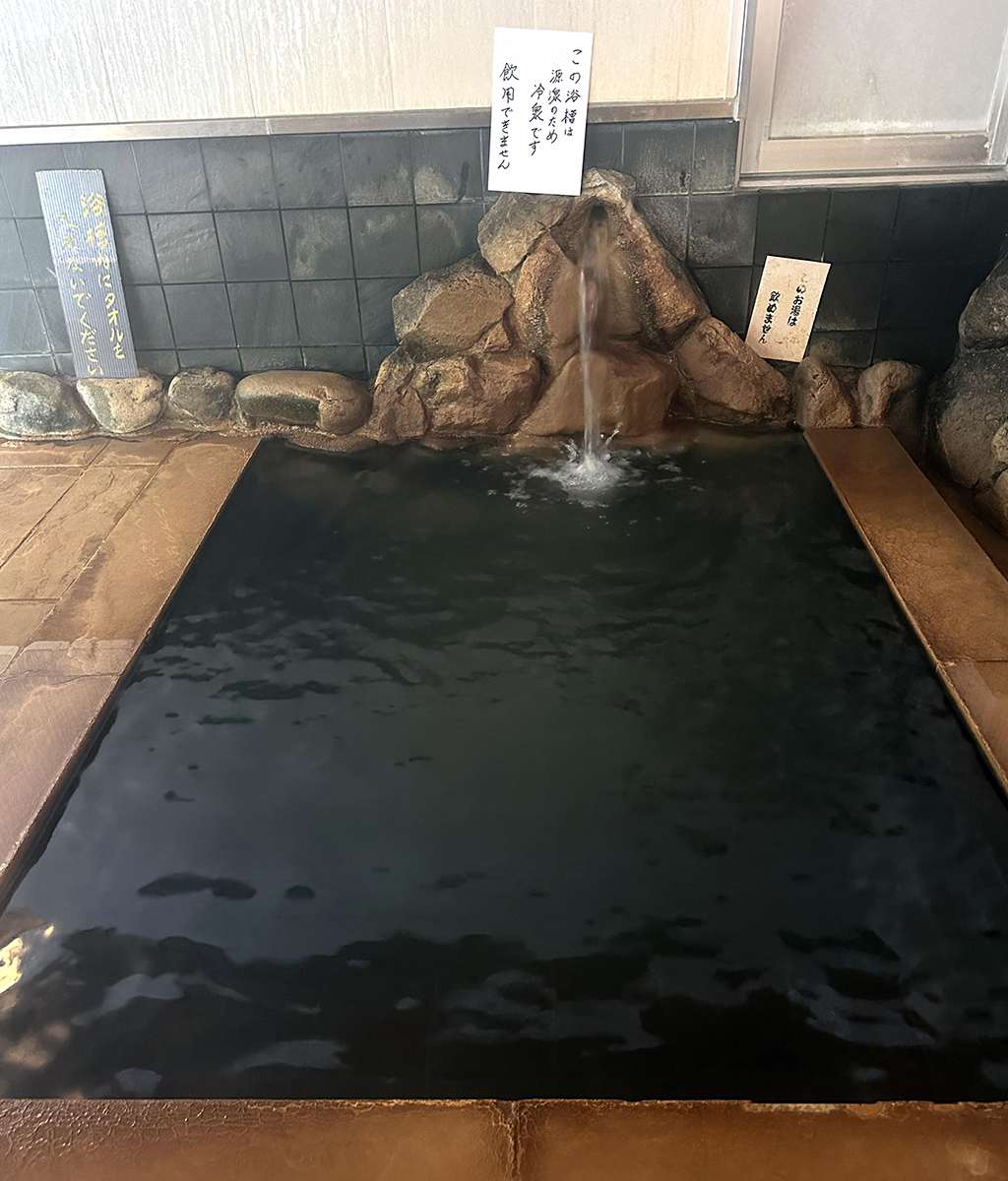
Highly carbonated hot spring water flows directly from underground into the baths at Senyukan.
-
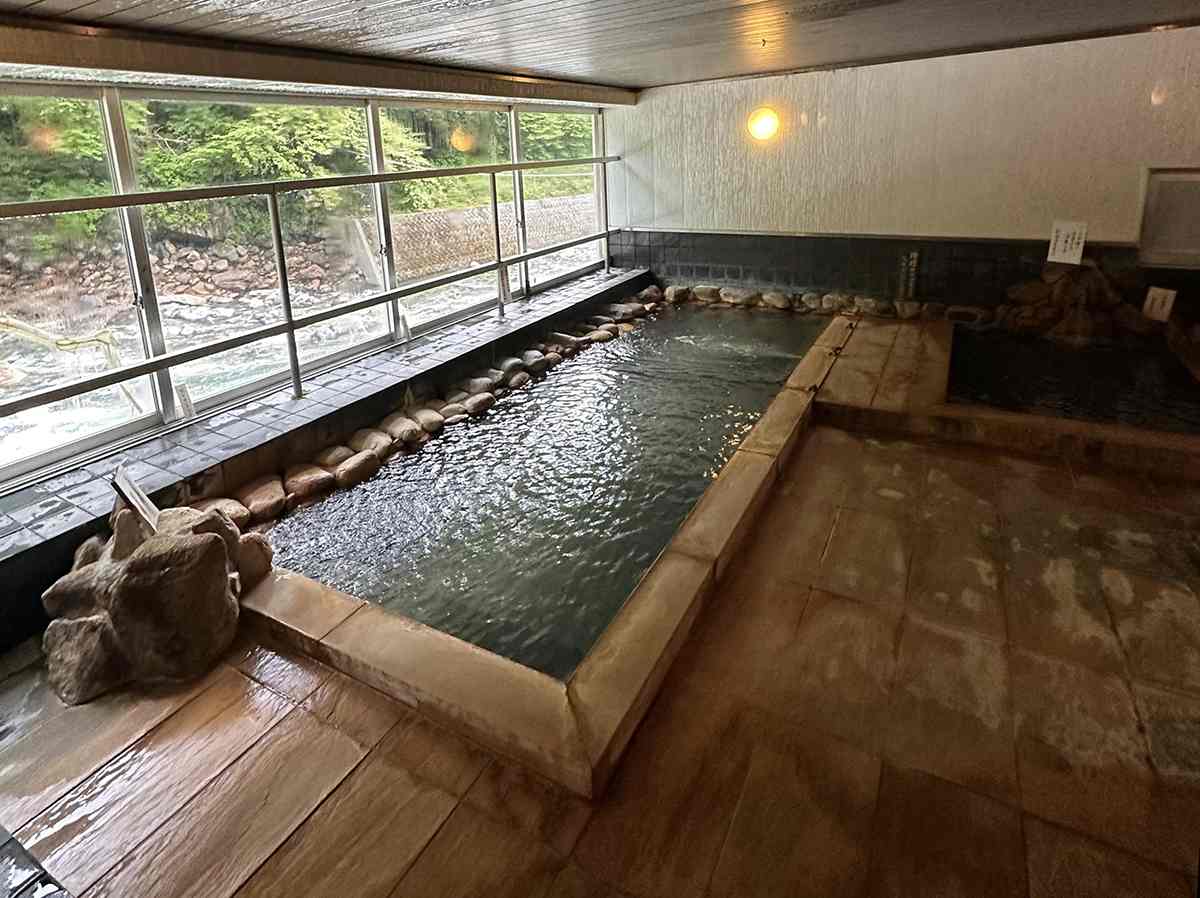
An indoor hot spring bath
-
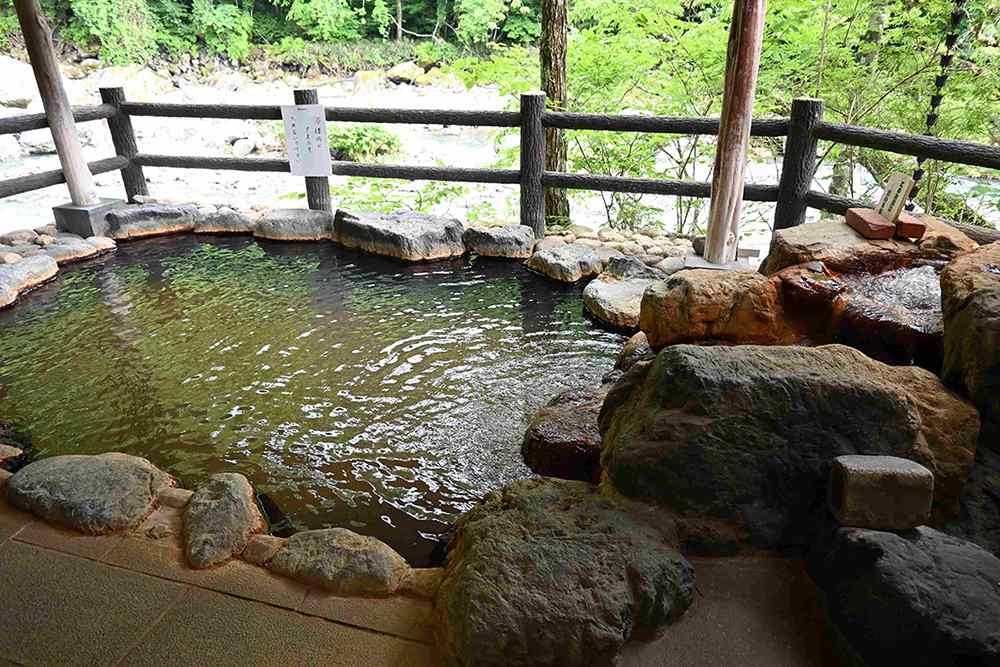
An open-air hot spring bath faces the river.
-
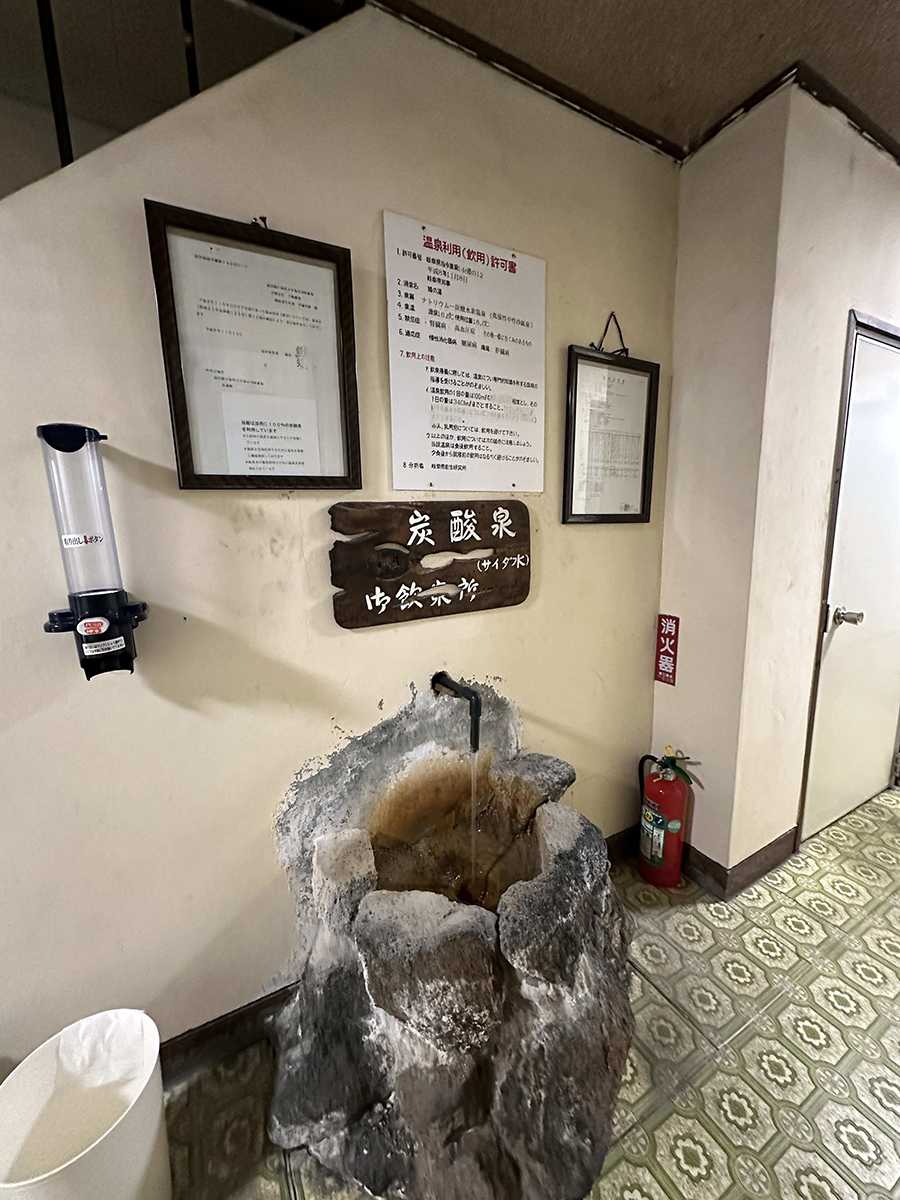
A place inside Senyukan where guests can drink the hot spring water.
-
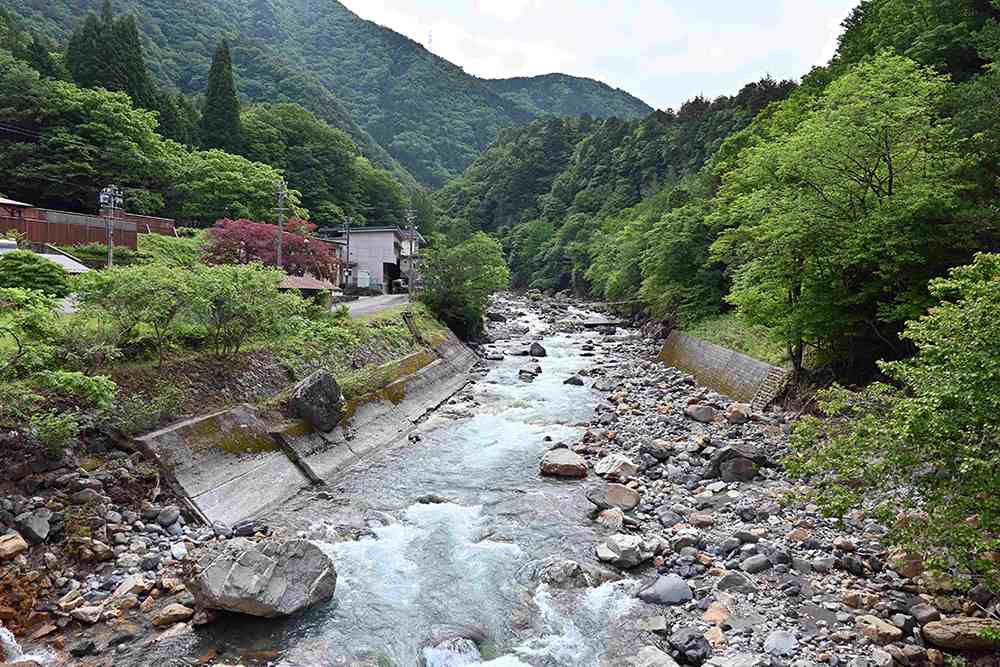
A river that runs in front of Senyukan
-
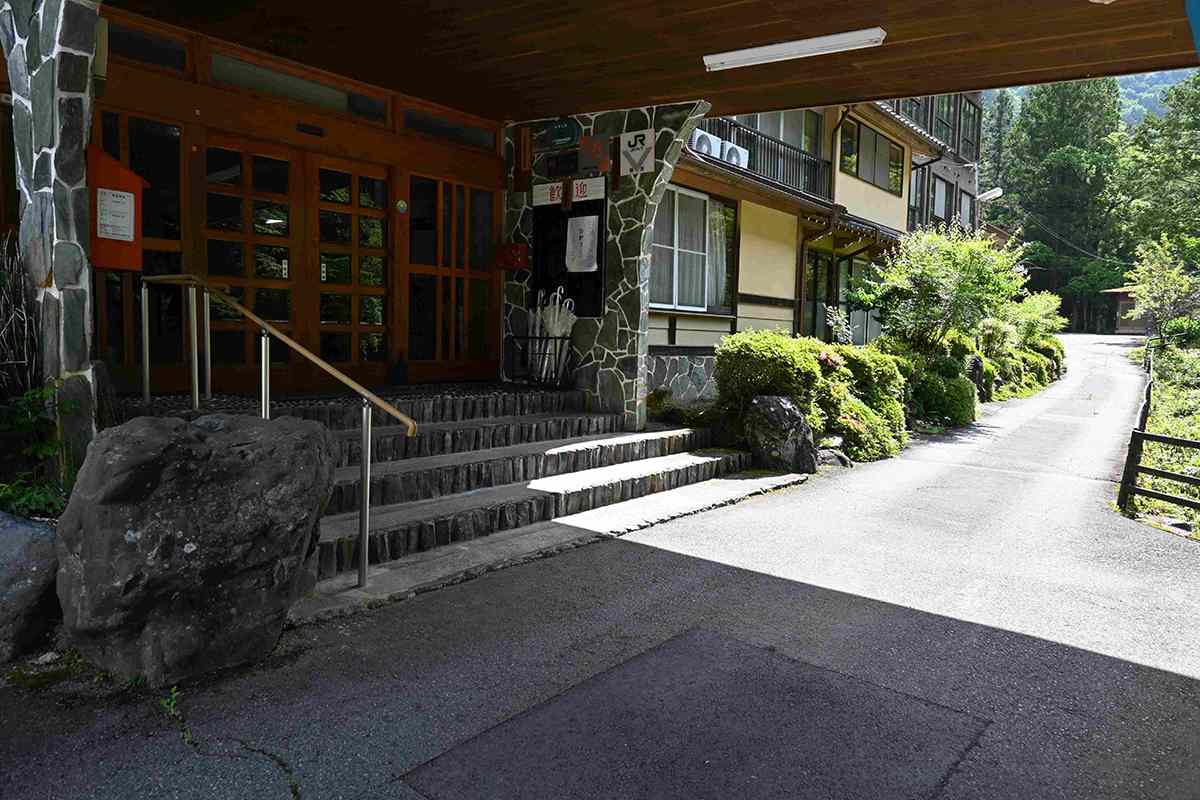
Senyukan, a ryokan inn, located in Hida-Osaka
After my hike, I stayed at the nearby Shitajima Onsen Senyukan hot springs inn. Carbon dioxide gas dissolved in the water gives it a naturally high carbonation level. The springs are also called ramune sen (soda spring) and have historically been popular. Carbonated hot springs have a CO2 concentration of 250 parts per million or higher per liter of water. Hot springs with 1,000 ppm or higher are designated as highly carbonated. The water at Shitajima Onsen has a concentration of over 1,200 ppm, one of the highest in the country.
I quickly soaked myself in the outdoor and indoor hot spring baths. The open-air bath area had stone bathtubs overlooking the Nigorigo River. Underground spring water flows directly into one of indoor area baths. The source of the inn’s hot spring is about 16 C and is labeled as a “cold spring.” It contains various minerals such as iron, and the small bubbles that cling to the skin are said to promote blood circulation. After a long soak, I felt surprisingly light the next day. You can also drink the spring water, which is said to be good for the intestines, at a spot inside the inn.
-

Hiroko Ito, Senyukan’s fourth-generation proprietress stands in the lobby.
-
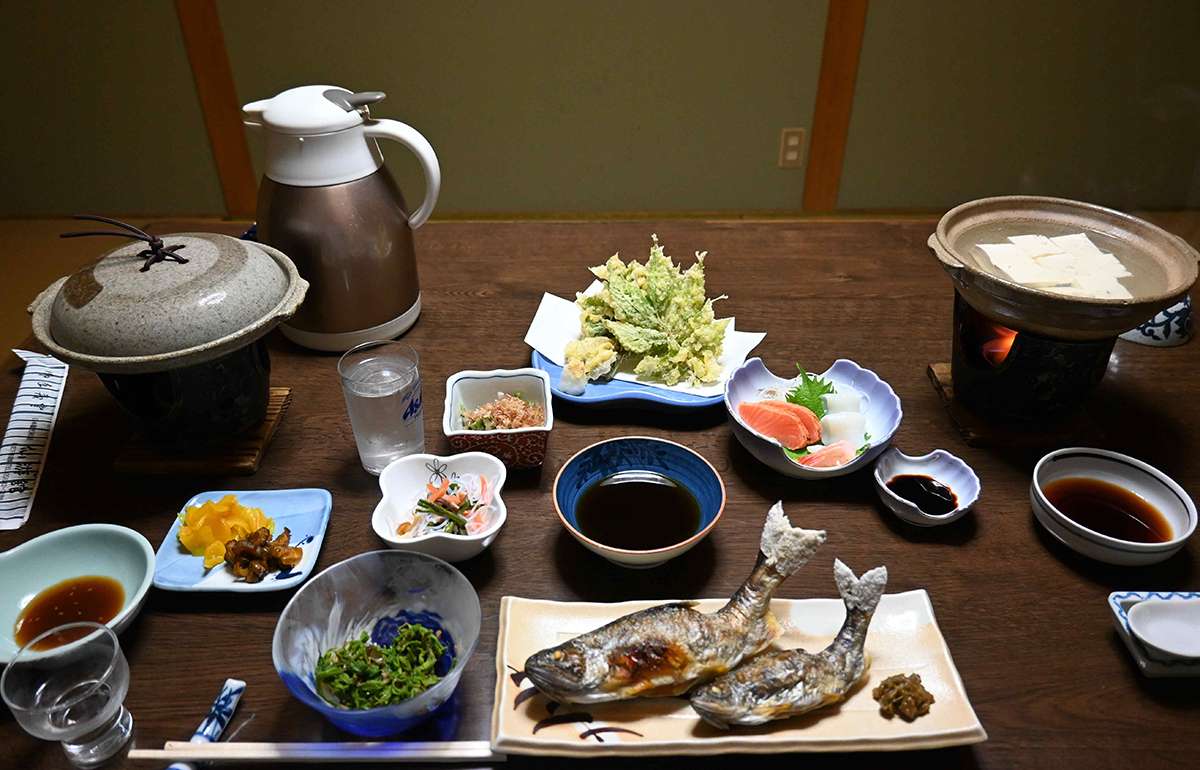
Dinner at Senyukan
-
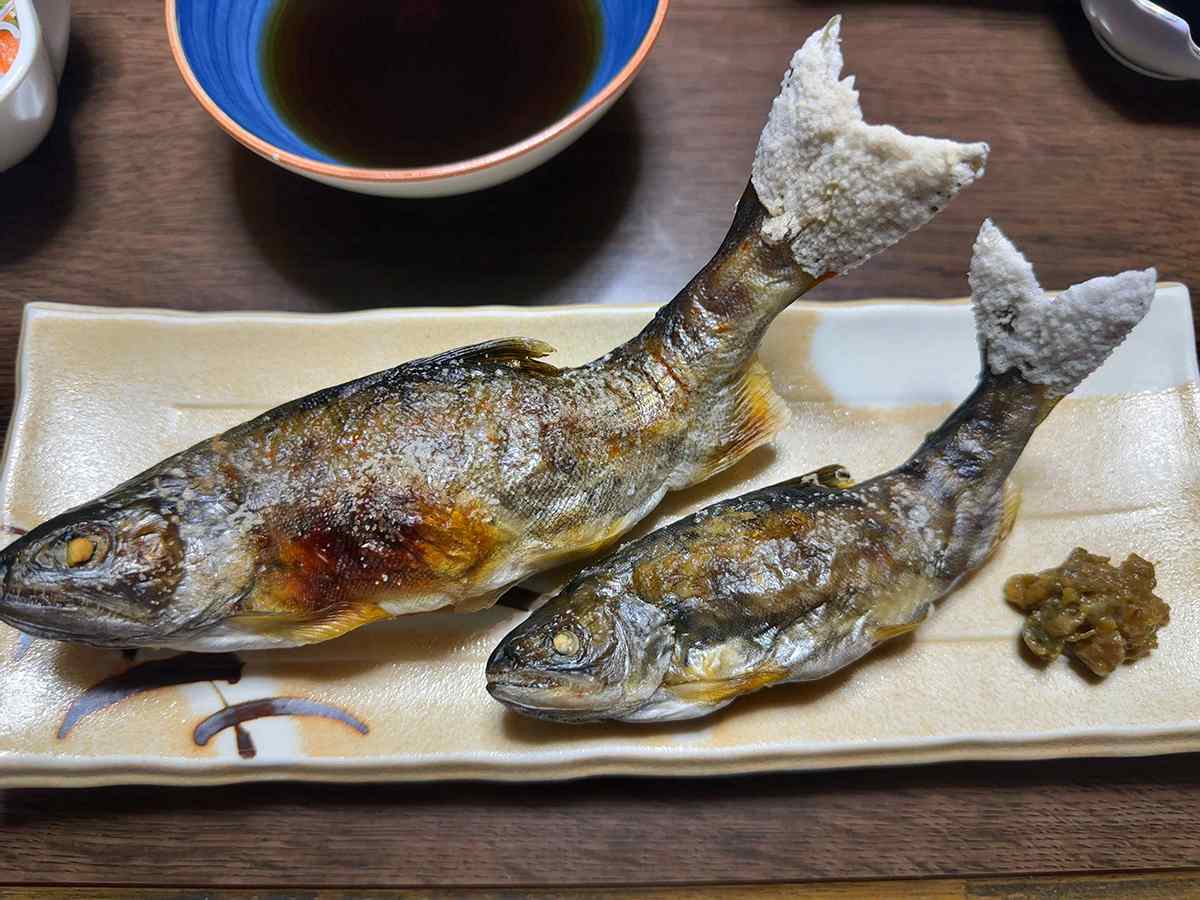
Grilled large amago trouts that the proprietress’ son caught in the river.
-
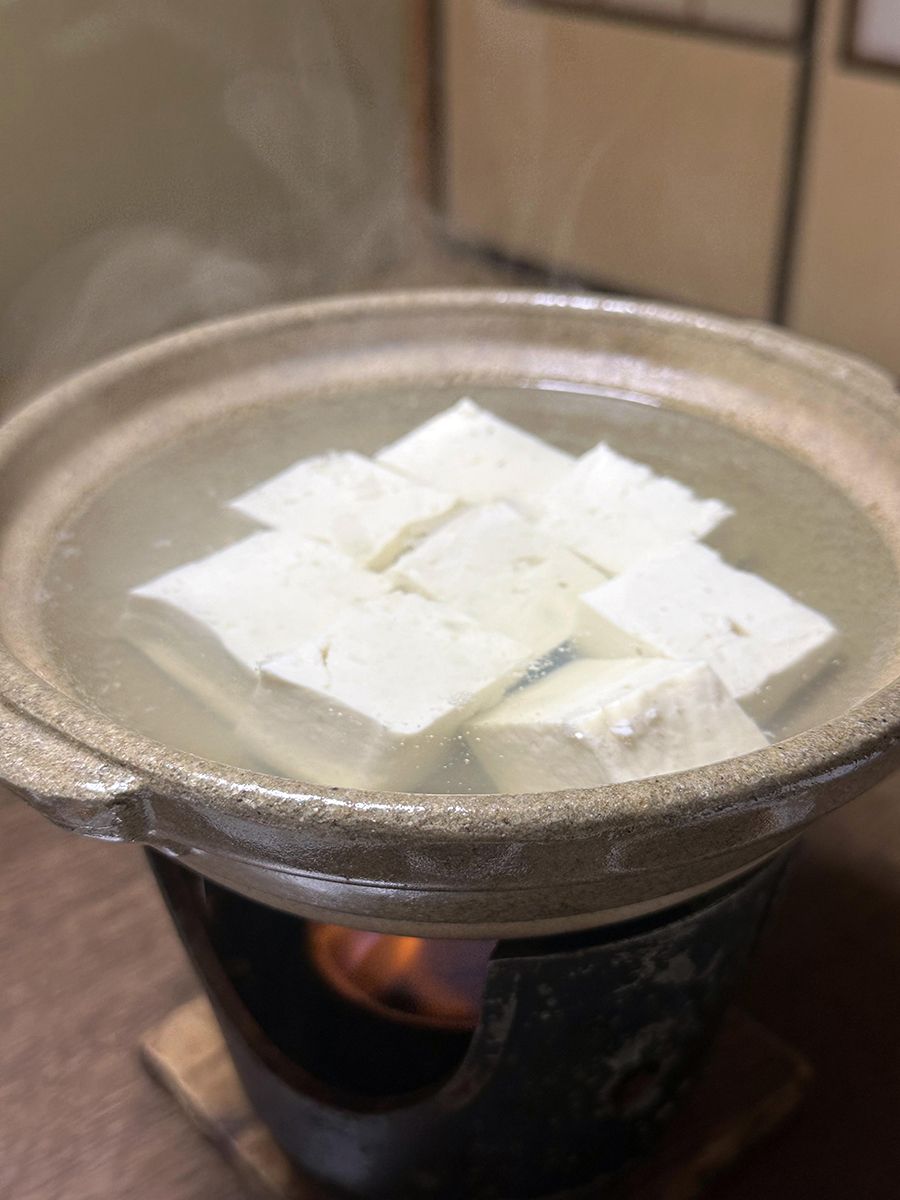
Senyukan’s signature dish, tofu boiled in carbonated hot spring water.
-
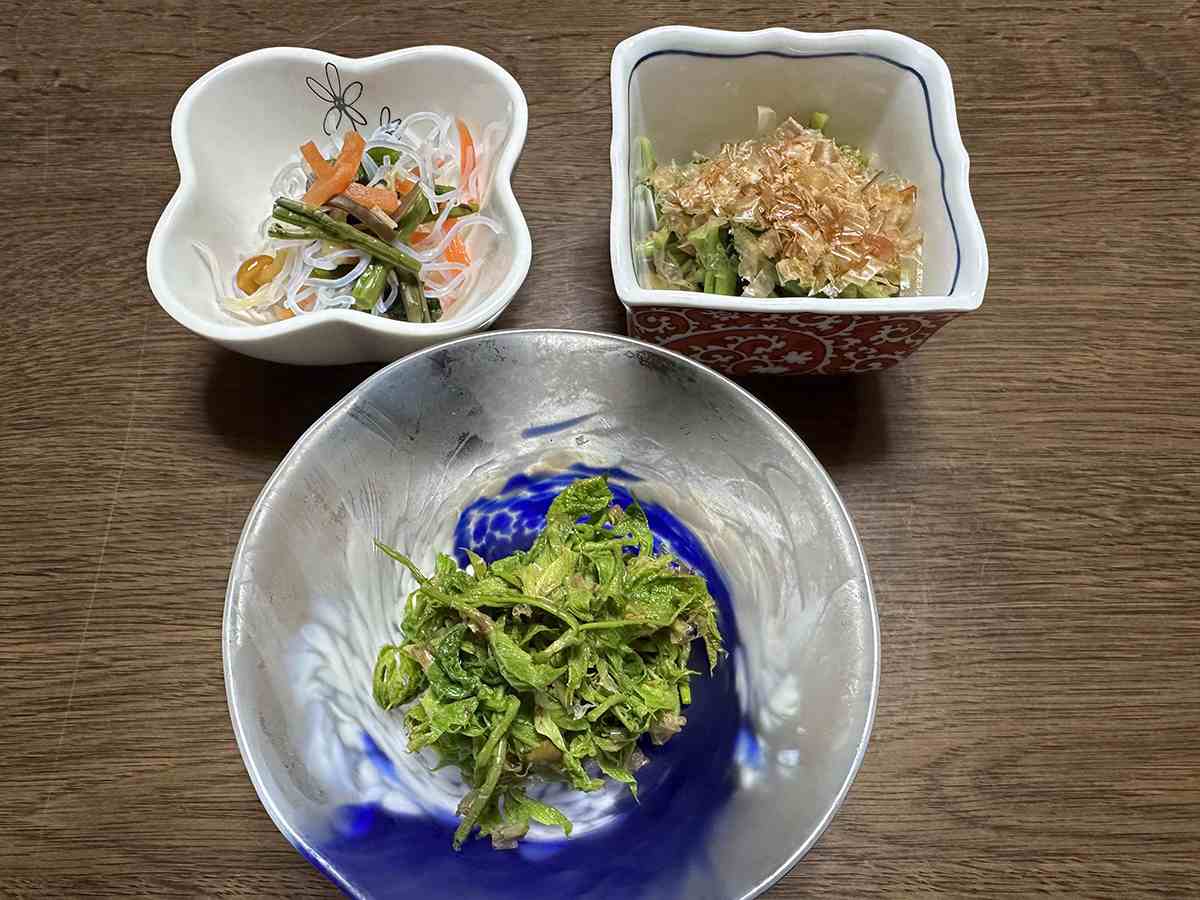
Small dishes of local vegetables
-
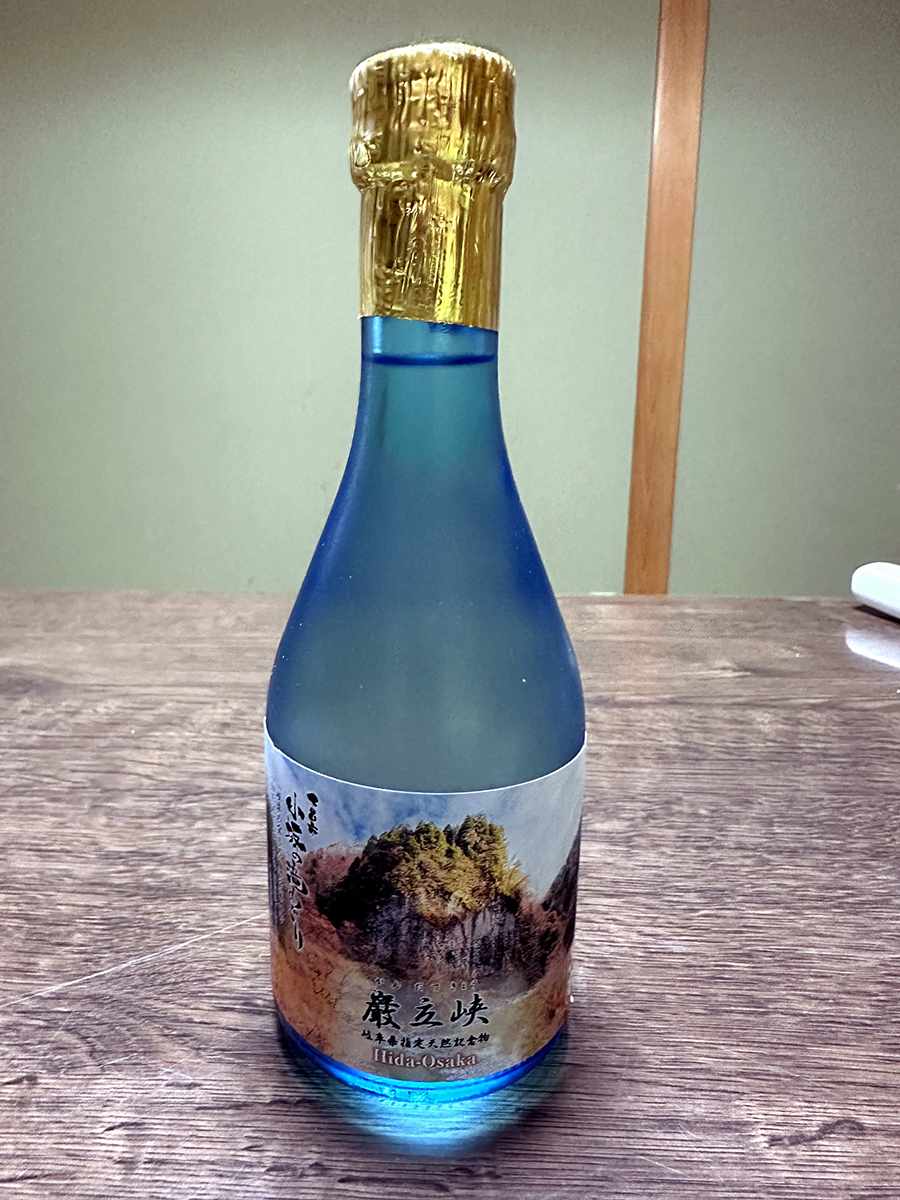
Gandatekyo, the local sake
-
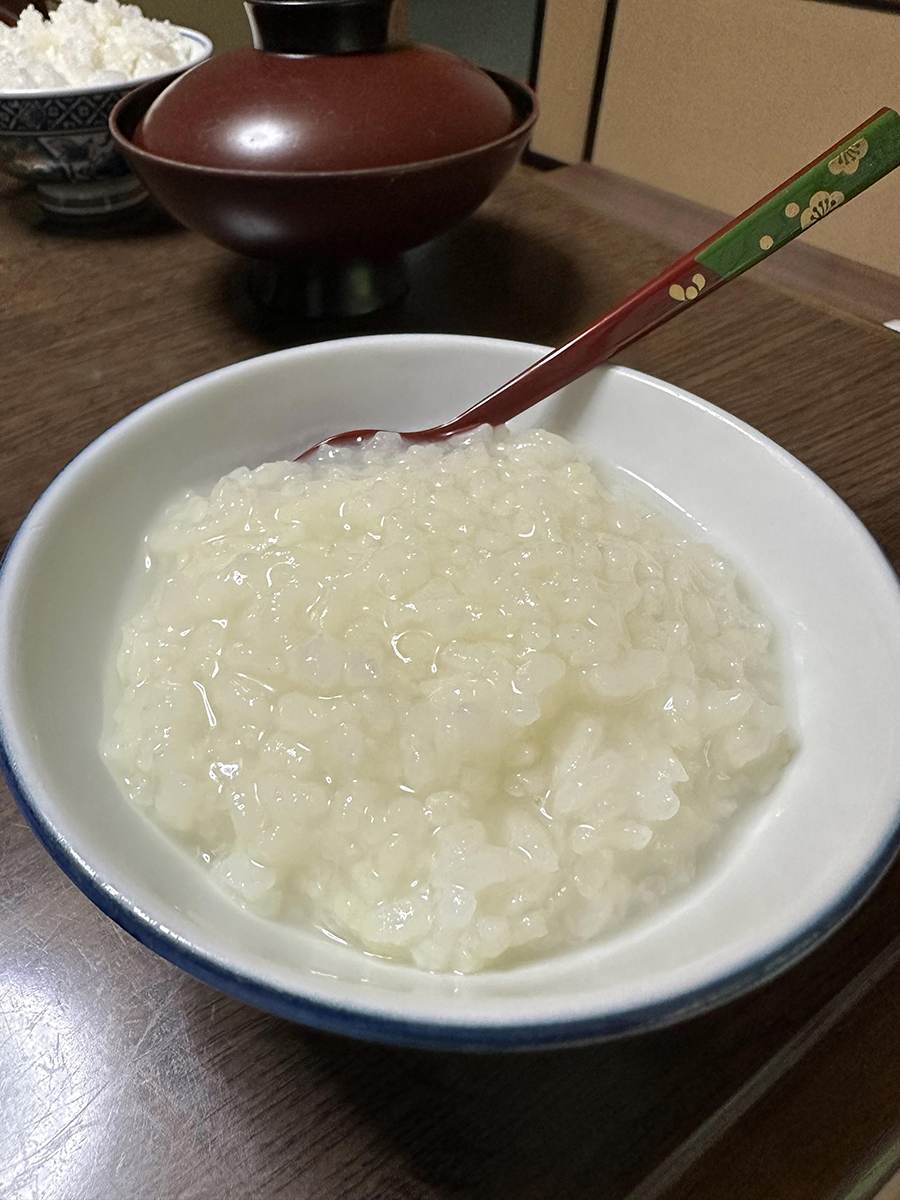
Breakfast porridge made with highly carbonated hot spring water
Hiroko Ito, 66, the fourth-generation proprietress, hosted me for dinner. The menu included a large grilled amago trout that her son had caught in the river, the area’s signature dish of tofu boiled in carbonated hot spring water, grilled Hida beef and local vegetables such as koshiabura and warabi. All the dishes were delicious and went well with the local sake. The inn was established in 1931, and the first owner was from Iwakura, Aichi Prefecture. The founder fell in love with the hot springs and opened the inn.
-
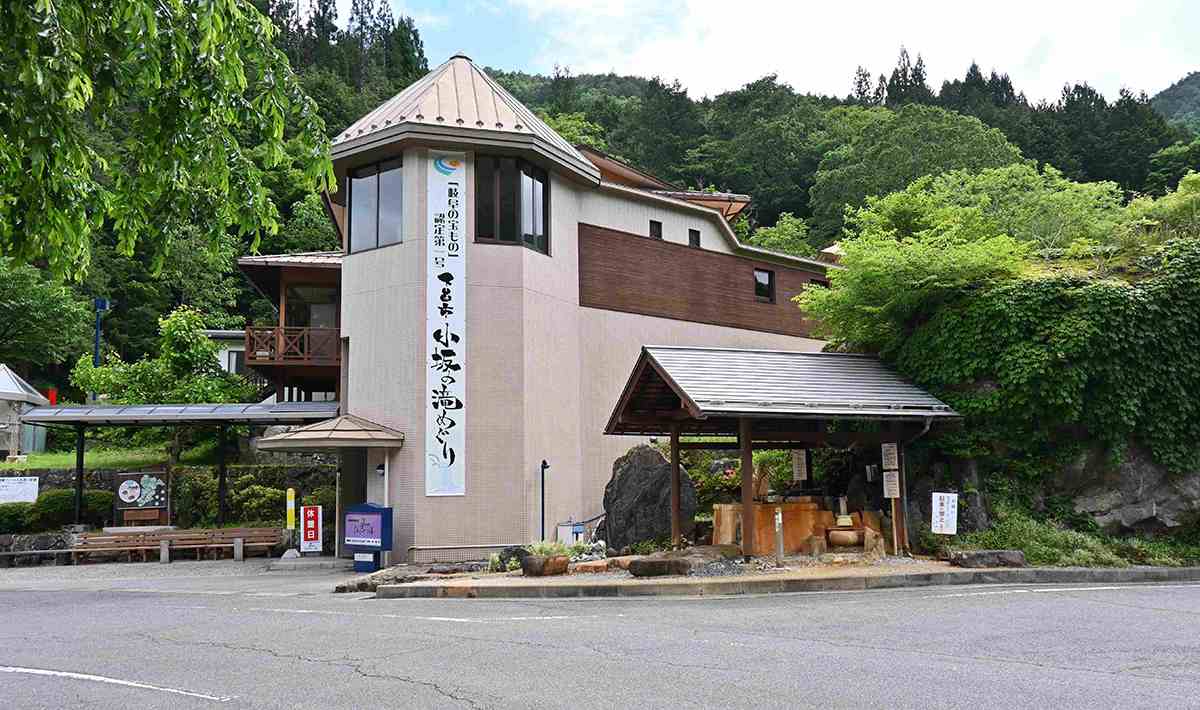
The newly renovated day spa, “Himeshaga no Yu”
-
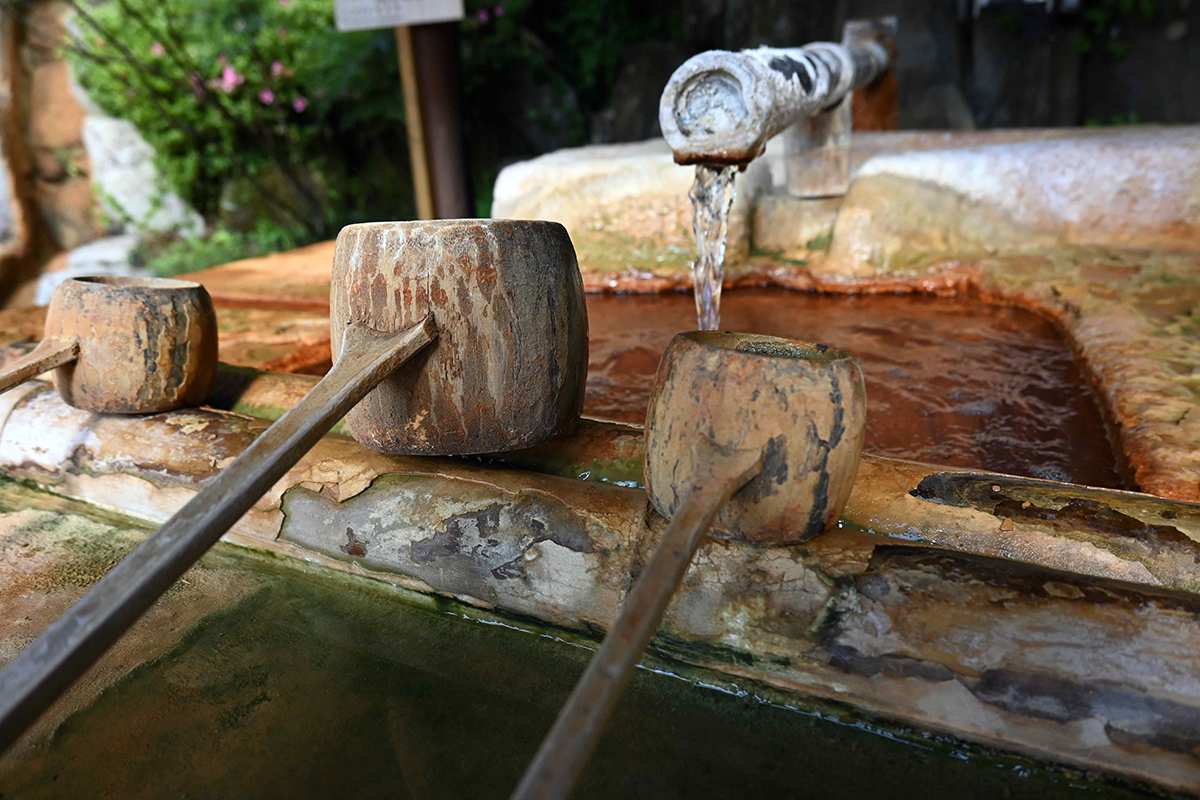
A place for drinking hot spring water in front of “Himeshaga no Yu.”
The Hida-Osaka waterfall tour and highly carbonated hot springs are full of charms that can only be experienced here. I felt the warmth of the people in the simple, casual atmosphere, which has not yet become a tourist attraction. I am sure I will return.
■For more information, please check:
"JN Specialities" POPULAR ARTICLE
-

Disaster Preparedness / Apartment Management Associations: Instructions on What to Do in the Event of Power Outage
-
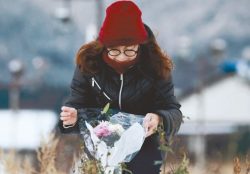
The Japan News / Weekly Edition (1/9-1/15)
-

Kawasaki Releases Guide to Sheltering at Home During Disasters, with Essential Tips for Apartment Residents
-
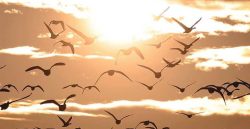
The Japan News / Weekly Edition (12/26-1/1)
-
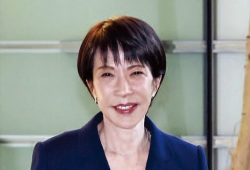
The Japan News / Weekly Edition (1/16-1/22)
JN ACCESS RANKING
-

Japan Govt Adopts Measures to Curb Mega Solar Power Plant Projects Amid Environmental Concerns
-

Core Inflation in Tokyo Slows in December but Stays above BOJ Target
-

Major Japan Firms’ Average Winter Bonus Tops ¥1 Mil.
-

Tokyo Zoo Wolf Believed to Have Used Vegetation Growing on Wall to Climb, Escape; Animal Living Happily after Recapture
-

JAL, ANA Cancel Flights During 3-day Holiday Weekend due to Blizzard
